- Trekking Himachal Uttarakhand Maharashtra Expeditions South India Kashmir Summer Kheerganga Trek Laka Glacier Trek Indrahar Pass Trek Bhrigu Lake Trek Hampta Pass Trek Beas Kund Trek Sar Pass Trek Prashar Lake Trek Moon Peak Trek Kasol Kheerganga Trek Rupin Pass Trek Winter Hampta Winter Trek Bir Winter Trek Dalhousie Winter Trek Sar Pass Circuit Trek All Season Kareri Lake Trek Grahan Trek Tosh Trek Triund Trek Summer Har Ki Dun Trek Rupin Pass Trek Bali Pass Trek Ali Bedni Trek Ruinsara Tal Trek Pangarchulla Trek Winter Kuari Pass Trek Chopta Chandarshila Tungnath Trek Brahmatal Trek Roopkund Trek Kedarkantha Trek All Season Dayara Bugyal Trek Gaumukh Tapovan Trek Nag Tibba Trek Monsoon Kedartal Trek Valley of Flowers Trek Forest Treks Kalsubai Trek Sandhan Valley Trek Andharban Trek Bhimashankar Trek Devkund Trek Fort Treks Rajmachi Trek Prabalmachi Trek Visapur Fort Trek Lohagad Fort Trek Nepal Everest Base Camp Annapurna Base Camp India Goechala Trek Chadar Trek Weekend Treks Kudremukh Trek Kodachadri Trek Kumara Parvatha Trek Gokarna Beach Trek Tadiandamol Trek Dudhsagar waterfall Trek Netravathi Peak Trek Bandaje Falls Trek Kurinjal Peak Trek Sunrise Treks Skandgiri Trek Uttari Betta Trek Kunti Betta Trek Anthargange Trek Savandurga Trek Makalidurga Trek Ramanagara Night Trek Nandi Hills Trekking Popular Treks Kashmir Great Lakes Trek Tarsar Marsar Trek Tulian Lake Trek Naranag Gangabal Trek
- Bike Trip Ladakh Others Full Circuit Manali Leh Srinagar Srinagar Leh Manali Exclusive Routes Delhi Srinagar Leh Delhi Leh Umling la Leh Manali to Leh Bike Trip Leh to Leh Leh to Leh (7D/6N) Leh to Leh (6D/5N) Other Bike Trips Uttarakhand Meghalaya Rann of Kutch Rajasthan tawang Bhutan
- Camping Himachal Uttarakhand Bangalore Mumbai Best for Camping Kasol Manali Kullu Workcation Workation camps in Bir Workation Cottage in Jibhi Workation camps in McLeod Ganj Workation Camps in Tosh Trending Camping Sites Rishikesh Kanatal Lansdowne In Bangalore Ramanagara Nandi Hills Kanakapura Nearby Bangalore Dandeli Coorg Camping Sakleshpur Camping Wayanad Camping Gokarna Camping and beach Trek Popular Pawna Lake Camping Bhandardara Camping Revdanda Beach Camping Offbeat Kolad Camping Karnala Camping
- Tours Uttarakhand Ladakh Goa Andaman Spiti Delhi to Delhi Karnataka Mumbai Departure Religious Tours Kedarnath Yatra Rishikesh Spiritual Do Dham Yatra Char Dham Yatra Popular Tours Rishikesh Rishikesh Food Walk Jim Corbett Rishikesh Night Walk Delhi to Auli Tour Popular Tours Manali To Srinagar Leh Ladakh From Delhi Srinagar To Leh Leh Turtuk Village Popular Tours 4 Days Goa Grande Island Backpacking Tours Backpacking Tour 8 Days Offbeat Honeymoon Tours Honeymoon Tour 5 Day Honeymoon Romantic Candlelight Beachside Honeymoon 4 Days Honeymoon Popular Tours Spiti From Manali Spiti Circuit Trending Tours Mcleodganj Triund Kasol Kheerganga Jibhi Tirthan Manali to Solang Valley Manali and Lahaul Trip Chopta Chandrashila trek Mcleodganj Kareri Trek Manali, Solang and Kasol Tour 1 Day Tour Packages Adiyogi Laser Show Adiyogi & Gudibande Fort DD Hills & Mandaragiri Hills Hogenakkal Waterfalls Mysore 2 Days Tour Packages Hampi Tour Package Kodaikanal Tour Package Munnar Tour Package Ooty Tour Package Wayanad Tour Package Chikmagalur Tour Package Coorg Tour Package Pondicherry Tour Package Dandeli Tour Package Sakleshpur Tour Package Kannur Tour Package Udupi Mangalore Tour Valparai Tour Package Thekkady Tour Package Br Hills Tour Package Badami Tour Package Gokarna Murudeshwar Gokarna Tour Package 3 Days Tour Packages Hampi Tour Package Chikmagalur Tour Package Coorg Tour Package Wayanad Tour Package Goa Tour Package Gokarna, Honnavara & Murudeshwar Gokarna, Dandeli & Murdeshwara Mumbai To Mumbai Hampi Gokarna Murudeshwar Dandeli Gokarna Murudeshwar
- Activities Air Activities Water Activities Land Activities Himalayas Paragliding In Bir Paragliding In Manali Paragliding at Dharamshala Bungee Jumping at Rishikesh Giant Swing in Rishikesh Flying Fox in Rishikesh Mumbai Kamshet Paragliding Helicopter Ride in Mumbai Rajasthan Parasailing in Jaisalmer Paramotoring in Jaisalmer Hot Air Balloon in Jaipur Bangalore Helicopter Ride Microlight Flying Bangalore Andaman Scuba In Andaman Scuba In Havelock Snorkeling Kayaking Glass Boat Ride Mumbai Cruise Dinner Helicopter Ride Kolad River Rafting Luxurious Boating Himalayas Rafting in Kullu Rafting in Rishikesh with Camping Goa Titos Club Big Daddy Casino Rajasthan Candle Light Dinner Quad Biking in Jaisalmer ATV Buggy Ride in Jaipur Paintball in Jaipur Jhalana Leopard Safari in Jaipur Bangalore Wine Tasting Tour Wonderla Amusement Park Maharashtra Kolad Camping
- Places India International Himalayas Jammu Kashmir Bir Bhuntar Tosh Tirthan valley Jibhi Kullu Manali Dharamshala Leh Kasol McLeodganj Spiti Valley Malana South India Bangalore Chikmagalur Coorg Hampi Mysore Dandeli Sakleshpur Others Andaman Nicobar Jaipur Best International Dubai Indonesia Thailand Singapore Malaysia
- Pilgrimage Uttarakhand By Helicopter Char Dham Yatra By Helicopter Do Dham Yatra By Helicopter Do Dham In 1 Day Hemkund Sahib In 1 Day Do Dham Ex- Sersi Kedarnath By Helicopter By Road Char Dham By Road Tungnath Temple By Road Kedarnath Yatra

Asawa Fort Trek
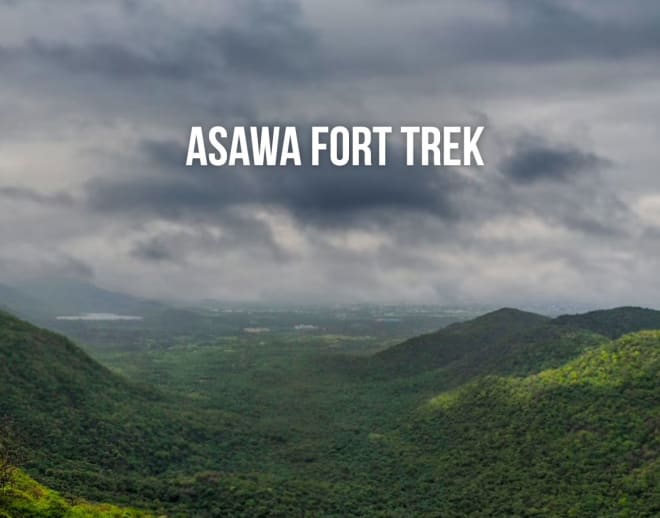
Asawa Fort Trek Highlights
- Easy booking
- Instant confirmation
- No hidden charges
Asawa Fort Trek Overview
In Thane District , Boisar is an important and old city. In old times, many ports were used for large scale trade with foreign countries. Some of these ports were Shurparak, Dahanu, Tarapur, Sristhanaka / Sthankiya Pattan (Thane), Kalyan (Kalyan) etc. The cargo that landed at this port was used to go to the country in different ways. The Forts were mainly built to protect and guard these routes. Asawa fort height is around 1080 feet and this trek is a Medium grade trek. The complete trek duration is 2 hours from base village And the Asawa fort region is the Palghar region. Price: Cost without transport: Rs. 799/- per person Cost with transport: Rs. 1499/- per person
Itinerary For Asawa Fort Trek
Day 1 - Asawa Trek Itinerary
Explore Asawa Trek
- 05:45 am: You will meet travel partners at Pritam Hotel, Dadar -East near Kotak Bank ATM.
- 06:00 am: You will Depart from Dadar in a private non-ac bus till base village.
- 06:15 am: Then Pick up at Kalaignar WEH bus stop, Bandra.
- 06:25 am: Then Pick up at the WEH metro station bus stop, Andheri.
- 06:35 am: There will be Pick up at Oberoi Mall, Goregaon.
- 06:50 am: Then the Pick up at Omkareshwar temple, Borivali.
- 07:10 am : Then Pick up at Fountain hotel, Ghodbunder.
- 07:35 am : Then Pick up at Vasai phata.
- 07:45 am: Then those who are traveling by their own transport will Meet us at Virar Phata
- 09:00 am: You will Reach base village. Then have your breakfast and a short introduction session.
- 09:30 am : You will Start your Trekking.
- 11:30 am: You will Reach the pinnacle and there explore the historic place.
- 12:30 am: Then you will Start descending.
- 14:00 pm : You will Reach base village and then have your lunch.
- 15:30 pm: You will start our return journey towards Mumbai.
- 19:00 pm : You will Reach Dadar and disperse.
Our Destination expert will be happy to help you resolve your queries for this tour.
- All in one platform
- Never Settle for Average
- Truly Unique Experiences
Select Package Options
Please select a tour date
Please select a tour package
Total Travellers
Variant description, things to carry, location details about asawa fort trek, starting point, pickup points.

Your Thane Travel itinerary is waiting.
Receive a curated itinerary featuring the most iconic experiences in Asawa Fort Trek, straight to your whatsapp.
Asawa Fort Trek FAQs
What is the difficulty level of the asawa fort trek.
The Asawa Fort Trek comes in the medium difficulty level
What is the best time for Asawa fort trek?
There is no such best time. Asawa Fort Trek can be done throughout the year.
Confirmation Policy
- Upon booking, the traveller will receive a confirmation voucher via email, within 24 hours.
- In the special cases of slots not being available, feasible alternatives will be provided to the customer, in regards to the customer’s preference. In such cases, a new voucher would be sent via email, consisting of the new travel details.
Cancellation Policy
- Any cancellation made 20 days prior to the date of departure, would levy a 30% of total tour cost as cancellation charges.
- Any cancellation made within 7-20 days prior to the date of departure, would levy a 60% of total tour cost as cancellation charges.
- Any cancellation made within 0-7 days prior to the date of departure, would levy a 100% of total tour cost as cancellation charges.
- Due to any restrictions such as sudden government policies or regulations, health hazards, medical emergencies, or unprecedented weather conditions, activities and tours may be nonoperational and be cancelled. In cases such as these, operators will attempt to cater to the traveller an alternate, which is feasible in nature. However, any refund would not be catered.
Refund Policy
- Any refund applicable will be processed within 7 business days.
Thane Top Attractions

More Thane Attractions
More things to do, best domestic packages, popular on banbanjara, places to visit in india, international places to visit.
Recommended
Popular Tours

Auli Package From Delhi
Starts from ₹6499

Spiti Valley Winter Tour From Delhi
Starts from ₹12500

Jibhi Tirthan Valley Trip from Delhi
Starts from ₹6999

Chopta Tungnath and Chandrashila Trek Package
Starts from ₹3899

Manali, Solang and Kasol Tour Package
Starts from ₹7100

Lakshadweep Tour Package From Mumbai
Starts from ₹22000

Bangalore to Coorg Tour Package
Starts from ₹3287

Bangalore to Kodaikanal Package
Starts from ₹6206

Kedarnath Yatra With Pick Up From Delhi & Haridwar
Starts from ₹8499
Trek Of india

Brahmatal Trek Package
Starts from ₹5699

Kedarkantha Trek Package
Starts from ₹5999

Kheerganga Trek with Camping
Starts from ₹1150

Triund Trek & Camping, McLeod Ganj
Starts from ₹830

Kuari Pass Trek with Camping
Starts from ₹7950

Kareri Lake Trek with Camping
Starts from ₹1500

Laka Glacier Trek via Triund
Starts from ₹3199

Dayara Bugyal Trek
Starts from ₹5299

Nag Tibba Trek
Starts from ₹1499
Log into Your Account
Create your account.

Trek to Asava (Asawa) fort - guarding Palghar and Dahanu
Asava fort (आसावा गड़) is located in Palghar on a hill about 1070 feet high. Palghar has eight forts divided into two groups - five sea forts that are along the coast to the west, and three hill forts on the sub-range of the Sahyadris to its east.
Asava fort is located at the north tip of this sub-range, with Tandulwadi fort at the southern tip and Kaldurg fort approximately in the center, next to the Chahad pass through which the Palghar-Manor road runs.
I was keen to explore Asava for I had already visited Tandulwadi and Kaldurg . I got the opportunity on one weekend in August 2016.
Due to the independence of the separate stalk eyes, the crab is able to use one eye to analyze the object's form, while simultaneously using the other eye to inquire about it's color and polarization features ( ref )
It was now time to start climbing down. I had read about a cave called Ganesh Gupha ( ref , ref ) that is on the east slope of the mountain that I did not want to miss.
But the lunch was great! I was famished and managed to tuck in the Malwani chicken curry and rotis with relish!
Satisfied with the weekend adventure, I headed back to Mumbai, thanking myself for not having tried this adventure on bicycle, for I would have had a hard time riding back after the trek!
- google maps
- Adventure Travel
Subscribe to our newsletter
Get the latest posts delivered right to your inbox.

Now check your inbox and click the link to confirm your subscription.
Please enter a valid email address
Oops! There was an error sending the email, please try later.
Ashutosh Bijoor
Adventurer, mathematician, software architect, cyclist, musician, aspiring wood worker
Recommended for you
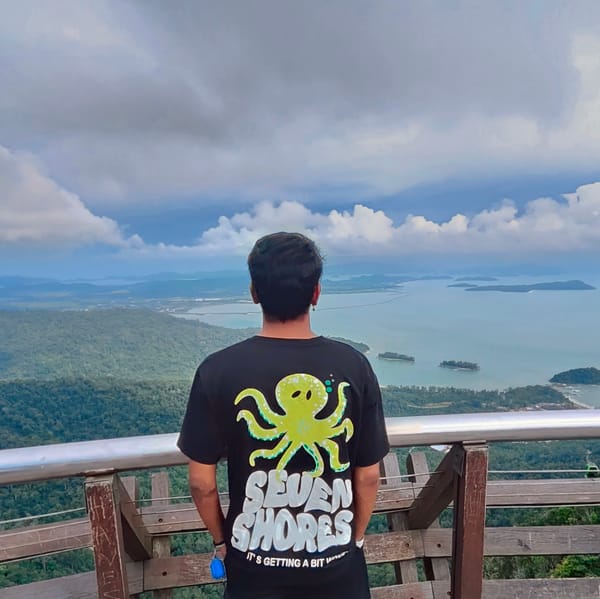
The Stillness Race

Mumbai's Hidden Heart

Inktober 2023 - Experiments with a fountain pen
Glacial Pace Adventures
Asawa fort-A beginner friendly hike near Mumbai

Asawa fort in Palghar district was built to supervise ports of Dahanu and Tarapur on critical coastal trade route along with many sea forts in the vicinity. A hike to this fort promises to be enjoyable for every fitness and experience level. Remains on the fort are bound to pique interest of every history buff. I particularly encourage you to take kids along to showcase history not mentioned in any text book.
Distance: 6 km
Elevation Gain: 290 m (951 ft )
Difficulty: Easy
Base Village: Route 1 from Warangade (Easy and scope of this blog) Route 2 from Mamacha Gaon Resort near Gundale (Steep of moderate grade)
Time Taken: 1.5 hr ascend at a leisurely pace 1 hr descend
How to get there?
Boisar is the nearest railway station from where one can choose to travel by share rickshaw or state transport bus heading towards Thane or Kalyan. Alight at Warangade village.
If you plan to travel by private vehicle, stay on Mumbai- Ahmedabad highway till Chilhar and then drive towards either of the base villages on Boisar road.
When is the right time to do this trek?

Since the fort doesn’t climb high, it is doable throughout the year except for very hot days in summer. Also, a word of caution to not indulge in hiking through Route 2 during rainy season. The rock patch gets quite slippery.
Trail head to the fort lies behind a factory across a narrow canal system. Cross the bridge over the canal and begin the ascend which is gradual. The route is easy to navigate and marked with arrows at many sections.

This first ascend, brings you to the top of a ridge which overlooks the western surroundings of the fort. This section has a good tree cover and I remember it to be my favorite section with enchanting sounds of birds in the early hours of the hike. Take a breather here and tune in to dawn chorus. Gentle pace of the trail rarely leaves you out of breath and before you know it you get first glimpse of the orange flag fluttering on top of the fort. The final summit push is bound to excite even a novice.

As you ascend through a rocky trail, you are greeted by two cannons which are in good condition. Further ahead are two water cistern and a huge step well. Fortification remains include a walled section and a dilapidated Maha Darwaja. Another unique feature on this fort is a huge cave called Ganesh Gupha on the eastern side of the hill. This would be your first point of interest if you choose to ascend from Mamacha Gaon Resort. An experienced hiker can opt to descend way route 2.
What other treks in the area should I consider too?

Asawa fort stands at the far north end of a sub mountain range with Kaldurg fort in the center and Tandulwadi fort at the other end. Another fort to consider for an easy grade hike in the vicinity is Asherigad.
Share this:
Published by glacial pace adventures.
Onwards and Upwards View more posts
3 thoughts on “ Asawa fort-A beginner friendly hike near Mumbai ”
- Pingback: Kaldurg fort – Glacial Pace Adventures
- Pingback: Takmak fort – Glacial Pace Adventures
- Pingback: Tandulwadi Fort – Glacial Pace Adventures
Leave a comment Cancel reply

- Already have a WordPress.com account? Log in now.
- Subscribe Subscribed
- Copy shortlink
- Report this content
- View post in Reader
- Manage subscriptions
- Collapse this bar

Asawa/Asava Fort Low Budget from Mumbai by Public Transport
Asawa /asava fort information:.
The height of fort is approx 1080 ft. The fort has 3 water tanks and 2 caves in which one is huge and other one is small. There are no much records available about this fort but it might have been a watch tower to guard surrounding area. Asawa fort low budget.
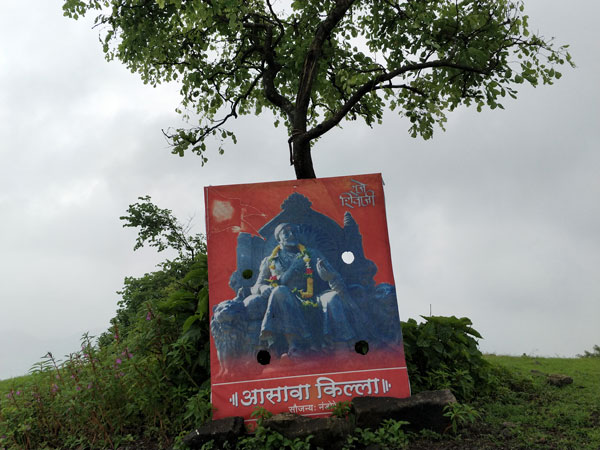
Best time to visit:
Throughout the year
How to reach base village (Warangade):
By public transport:.
Reach Boisar station, situated on the Western Line of Mumbai Railway division. Direct local trains are available from Churchgate to Dahanu Road (one can also travel from the Central Line to Vasai and from there board a train to Dahanu road and get down at Boisar ) From the station, reach Boisar bus stop and hop in a bus going towards Thane or Kalyan (Frequency 20min) and alight at Warangade village.
You can also opt for sharing rickshaws which are available outside Boisar railway station.
Take the Mumbai – Ahmedabad highway, reach Boisar from Chilhar phata; Warangade village is 10km from here.
TIP: Best Options is to Rent a self Driven Car
Water availability:
Throughout the year.
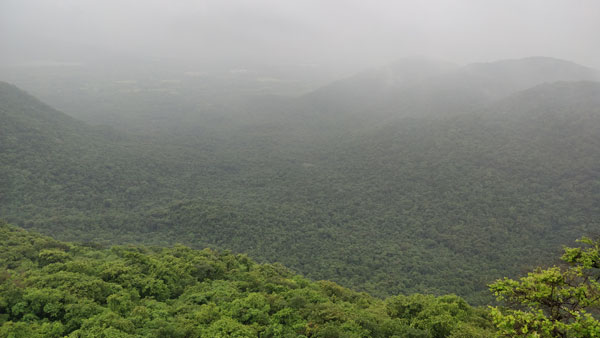
Things you need to carry:
- 2 litres water
- Snacks like biscuits, ready to eat food
Food and stay arrangement:
- You need to carry eatables
- You can set your tent on the fort
SUGGESTION: BEST AND BUDGET TENT FOR NIGHT STAY ON ASAVA FORT
Places to see:
Fortification of the fort, A huge cave, Water tanks on the top.
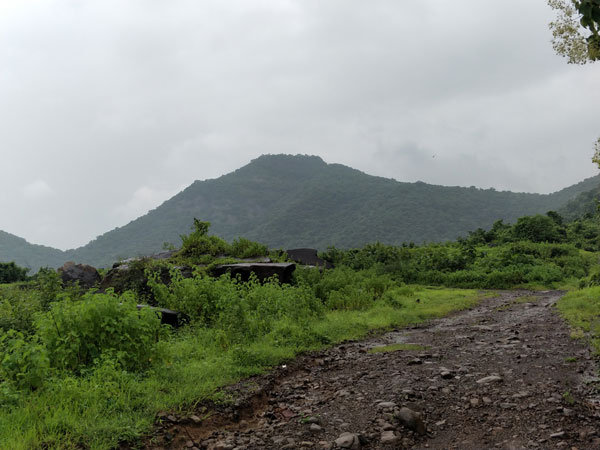

My personal Experience and A Step By Step guide for you:
I started my journey from Bhayander station by boarding 05:57 AM train to Dahanu Road and alighted at Boisar station and straight away headed to the bus stand to reach Warangade village. You can enquire about your place of interest with bus transportation staff. On asking, I was guided to a bus going towards Kalyan. The journey was of about 30 minutes.
Reaching Warangade I went on a road beside a telecom network tower after about 20 minutes of walking I saw a shop where I inquired about the route and then proceeded further. From there going straight for about 10 minutes, you will come across a small canal type stream to the right and cross it from the first small bridge you spot.
The fort is on to left hand and on the trail you will cross two small mountains and then through a dense forest offering a pleasant walk. After about 1 hour of walking, I reached the top and explored the fort and returned back after having a peaceful trek.
To sum up the cost of trek:
Bhayander to Boisar station return ticket (Indian Railway) = Rs. 40.
Took paratha’s (Home made) : Rs 0.
Boisar to Warangade (Public bus transport ) : Rs. 07.
Warangade to Boisar (Public bus transport ) : Rs. 07.
So the total expense of the trek was Rs. 54.
TIPS/HACKS/SUGGESTION: I bet without this you won’t Go for an Outing
Join our Broadcast List for Travel and Trek News, Updates and blog by a Text on Whatsapp – 9762124690.
Open up and be spontaneous to Comment on your own Trekraw Family Blogs (PS: I am one of you)
4 thoughts on “Asawa/Asava Fort Low Budget from Mumbai by Public Transport”
I was just looking for some interesting and not so crowded trekking route near mumbai. Thanks for this budget guide, it is really helpful for the budget travelers like me .
The trail is through the dense forest, you will surely enjoy this trek!!!!
Does this fort have platue at top to accommodate 50 to 60 people
Yes, You need to carry your own bedding.
Leave a Comment Cancel reply
Save my name, email, and website in this browser for the next time I comment.
All the data shown above will be stored by Trekraw on trekraw.com At any point of time, you can contact us and select the data you wish to anonymise or delete so it cannot be linked to your email address any longer. When your data is anonymised or deleted, you will receive an email confirmation. We also use cookies and/or similar technologies to analyse customer behaviour, administer the website, track users' movements, and to collect information about users. This is done in order to personalise and enhance your experience with us. Click here to read our Cookie Policy.
I have read and accepted the Privacy Policy *
By using this form you agree with the storage and handling of your data by this website. *

- Maharashtra
Unlocking History: Explore Asawa Fort's Secrets
- Unlock Your Savings: Sign Up Today & Get 200 Rs Off Your Next Booking!!!
Things to do in Maharashtra
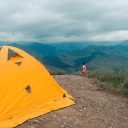
One Day Trips
Asawa fort: unveiling india's ancient fortress.
Asawa Fort stands as a testament to the country’s rich historical legacy amidst the rugged terrain of Maharastra, India . Perched atop a majestic hill, this ancient fortress bears witness to centuries of conquests, conflicts, and cultural evolution. Embarking on a trekking journey to the Fort unveils a tapestry of history, offering visitors a glimpse into India’s storied past and a captivating experience unlike any other.
Dating back to the medieval era, Asawa Fort has withstood the test of time, serving as a strategic stronghold for various rulers throughout history. Originally built by the Rajputs, it later came under the rule of the Marathas and Mughals, each leaving their indelible mark on its walls. The fort’s strategic location offered commanding views of the surrounding landscape, making it a prized possession for any aspiring conqueror.
Experience:
Visiting Asawa Fort is not merely a journey through history; it’s an immersive experience that transports visitors back in time. As you traverse the winding paths and ascend the fort’s ramparts, you can almost hear the echoes of bygone eras whispering through the ancient stones. The panoramic vistas from the fortifications provide a breathtaking backdrop, offering a glimpse into the challenges and triumphs of those who once defended this bastion.
Architecture:
The architectural marvels within Asawa Fort reflect the ingenuity and craftsmanship of its builders. From intricately carved gateways to sturdy bastions, every facet of the fort tells a story of resilience and determination. The intricate design elements, coupled with the natural beauty surrounding the fort, create a surreal ambiance that transports visitors to a bygone era.
Cultural Significance:
Beyond its military importance, Asawa Fort holds immense cultural significance for the region. It served as a center of trade, religion, and governance, shaping the social fabric of the surrounding communities. Today, it stands as a symbol of heritage and identity, drawing visitors from far and wide to witness its grandeur and pay homage to the generations of people who called it home.
The details of the trek to Asawa Fort
Tentative itinerary for the trek to asawa fort.
07:45 AM: Leave Mumbai
09:00 AM: Reach the base village, have breakfast
09:30 AM: Start Trekking.
11:30 AM: Reach the pinnacle and explore the historic place.
12:30 PM: Start descending.
02:00 PM: Reach the base village and have lunch.
03:30 PM: Begin the return journey towards Mumbai.
07:00 PM: Reach Dadar and disperse.
Conclusion:
A visit to Asawa Fort is not just a sightseeing excursion; it’s a journey through the annals of India’s history. Whether you’re a history buff, a nature enthusiast, or simply seeking a moment of tranquility amidst ancient ruins, this majestic fortress offers an experience that will leave an indelible mark on your soul. So, come, explore Asawa Fort, and embark on a timeless voyage through India’s captivating past.
- Sondai Fort Trek
- Visapur Fort Trek
- Aadrai Jungle Trek
- Harihar Fort Trek
- Bhairavgad Trek
- Rajmachi Point Trek
- Kalsubai Peak Trek
- Salher Fort Trek
- Torna Fort Trek
- Rajmachi Point
- Irshal Fort
- Kavnai Fort
- Ghangad Fort
- Forts In Maharashtra
- Camping In Igatpuri
- Conquering Kalsubai
- Sandhan Valley
- Pavana Lake From Pune
- Trekking Near Mumbai
- Kalsubai Trek Distance

Host Events
- How It Works
- List Your Events
Discover Events
- Chikkamagaluru
Collaboration
- Corporate Outing
- Feature Request
- Write For Us
Copyright © 2024 EventsErica
- Create account
Lost your password?
Please enter your email address. You will receive a link to create a new password via email.
Send Message
My favorites.
Trekking Experiences!
Sunday, september 13, 2009.
- Asawagad Trek

No comments:
Post a Comment
Blog Archive
- ► October (2)
- ► August (8)
- ► March (12)
- Dronagiri Fort
- Belapur Fort
- Sewree fort
- Dharavi Fort (Kala Killa)
- Sion fort (Shiv cha Killa)
- Jivdhani Fort
- Dativare (Sea fort) visit
- Tandulwadi fort trek
- Kaldurg Trek
- ► August (1)
- ► April (1)
- ► March (3)
- ► February (2)
- ► January (2)
- ► November (1)
- ► September (4)
- ► January (1)
- ► December (4)
- ► September (1)
- ► May (3)
- ► April (10)
Mumbai Hikers
« All Events
- This event has passed.
One day trek to Asawa Fort
July 17, 2022 @ 6:00 am.
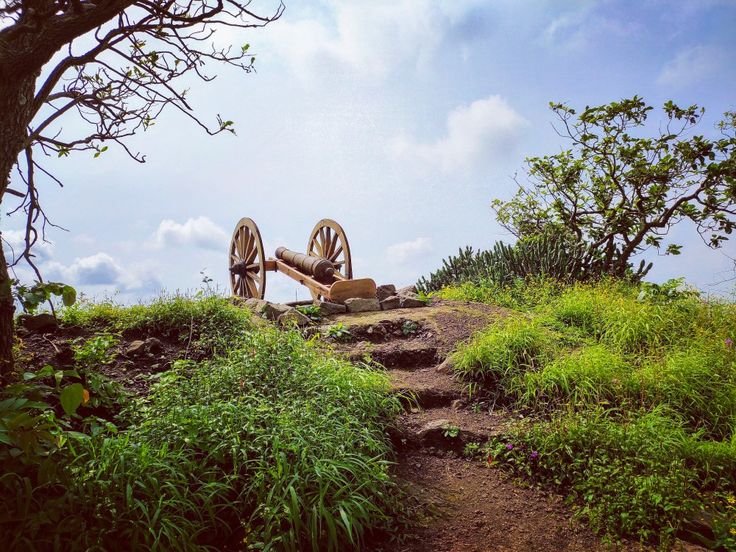
One day trek to Asawa Fort Organised by Save Tours
Asawa is an offbeat trek & one of the most scenic trek of Palghar region. So Join us for this exciting monsoon trek…
Key points of Trek – Beautiful View from Top – Explore remains of fortification – Offbeat & less crowded Destination
Grade: Medium Date: 17 July ’22 (Sunday)
Pickup Point: Borivali Station at 6 AM. Route & Pickup: Borivali Station- Borivali National Park- Fountain Hotel, Ghodbandar – Virar Highway
Trek cost: 1080 Rs. Includes: – Travelling by Pvt bus from Mumbai – Tea – breakfast – Lunch Veg- Nonveg – First-aid, experts and guide charges Max batch size: 30 Trekkers
For more details please contact : Save Tours 8655563635 (Also on WhatsApp) Office : 9136843033
WhatsApp us on 8655563635 to get regular updates of our Trekking & Camping events.
Check More Details here : https://savetoursandtravels.com/tours/asawa/
https://www.facebook.com/events/3125485024430502/
- Google Calendar
- Outlook 365
- Outlook Live

Maharashtra Forts Explore
Lets explore forts and trekking spots of maharashtra. if you are not exploring you are not living your life., nakhind trek.
I have shared my exciting experience of the Nakhind ridge trek. It is a one day budget trek.
Asawa Fort trek
Sharing my experience to the Asawa fort. Hope it is worth your time.
Kohoj Fort Trek
Date: 15th June 2019 Grade: Easy Endurance: Medium Height: 3200 feet Nearest Railway station: Palghar Cost: 150 per person Base village: Vaghote History: It is said that Kohoj Fort is about 800 years old and belongs to Bhoj-Dynasty. Kohoj Fort was built by King of Gujarat. Portuguese captured this fort from the King of Gujarat in…
Prabalgad & Kalavantin trek in Fireflies festival
Date: 1st & 2nd & June 2019 Grade: Easy (Difficult in monsoon) Nearest Railway station: Panvel Cost: 400 per person Base village: Thakurwadi History: From the study of the caves in this fort, it is estimated that it belongs to the time of Buddha. The Shilahar and Yadav dynasties made it an army camp because of…
Harishchandragad trek from Khireshwar
Date: 2nd & 3rd February 2019 Height: 4691 ft. Grade: Medium (Difficult in monsoon) Nearest Railway station: Kalyan Cost: 500 per person Gang: Rajeshwar, Shlok & Me Base village: Khireshwar History: The fort is quite ancient. Remnants of Microlithic man have been discovered here. The various Puranas (ancient scriptures) like Matsyapurana, Agnipurana, and Skandapurana include many…
Ratangad Trek
Date: 26th & 27th January 2019 Height: 4250 ft. (1142 meters) Grade: Easy (from Ratanwadi) Nearest Railway station: Kasara or Igatpuri Cost: 500-800 per person Gang: Soham, Prachi & Me Base village: Ratanwadi, Samrad History: Ratangad as the name suggests Ratan (means Jewels). Ratangad is also called the Jewel of the forts. The fort is 400…
Kothaligad Trek
Date: 22nd December 2018 Height: 3100 ft. Grade: Easy Nearest Railway station: Karjat Cost: 200 per person Gang: Soham, Prachi & Me Base village: Peth village History: Mughal Emperor Aurangzeb ordered his warriors ‘Abdul Kadar’ and ‘Ali Biradarkani’ in November 1684 to capture the forts belonging to Sambhaji’s empire. Abdul Kadar had a fair idea of…
Visapur Fort Trek
Date: 25th August 2018 Height: 3038 ft. Grade: Easy Nearest Railway station: Malavli Cost: 150 per person Gang: Prachi & Me History: Visapur fort was built much later than Lohagad by Balaji Vishwanath Bhat, the first Peshwa to Chhatrapati Shahu Maharaj in the earlier 18th century A.D. Visapur fort was built with the purpose of protecting…
Tahuli Trek – Kalyan
Date: 15th July 2018 Height: 3487 ft. Grade: Medium-Difficult (monsoon) Nearest Railway station: Kalyan Base: Kushiwali village Cost: 100 per person Gang: Only me (never go alone to this place during monsoon) About Tahuli: Tahuli actually is not a fort. Tahuli comes under regions of Kalyan, Karjat, and Panvel. Tahuli mountain contains a number of pinnacles….
Mahuli fort and Bhandargad trek
Mahuli fort is the comes under Tansa wildlife scantuary. It is the highest peak of Thane. On the left of Mahuli there is another fort named Bhandargad and on the right there is Palasgad. This blog shares my experience to these series of forts. It was an one day trek.

- Already have a WordPress.com account? Log in now.
- Subscribe Subscribed
- Report this content
- View site in Reader
- Manage subscriptions
- Collapse this bar
You must be logged in to post a comment.

Share ×

Scan the QR code and open PeakVisor on your phone
❤ Wishlist ×
See all region register, peakvisor app, khanty-mansiysk autonomous okrug – ugra.
Welcome to the land of sheer silent whiteness. Its vast expanses are filled with fresh Arctic air, howling winds, and the spirit of true adventure. Come with us to the lands of the ancient Khanty and Mansi tribes that survived in this harsh climate of the Nether-Polar Urals . See the mountains that defy any logical or geological reason for their existence. Experience the wonders of this sparsely populated land where you can hardly see a human trace. Welcome to Yugra!
Flora & Fauna
Water resources, landmarks and tourism, major mountains, mount narodnaya, mount zaschita, mount neroyka, the pyramid mountain, samarovskaya mountain, ski and sports facilities, protected sites, reserves, national and natural parks, rivers and lakes, major cities, khanty-mansiysk.
The Khanty-Mansiysk Autonomous Area – Yugra (KhMAO) is located in the central part of the West Siberian Plain, stretching from west to east from the Ural Range to the Ob-Yenisei Watershed. The vast areas of this plain, as well as the Lower Priob region, are considered one of the most recently inhabited areas.
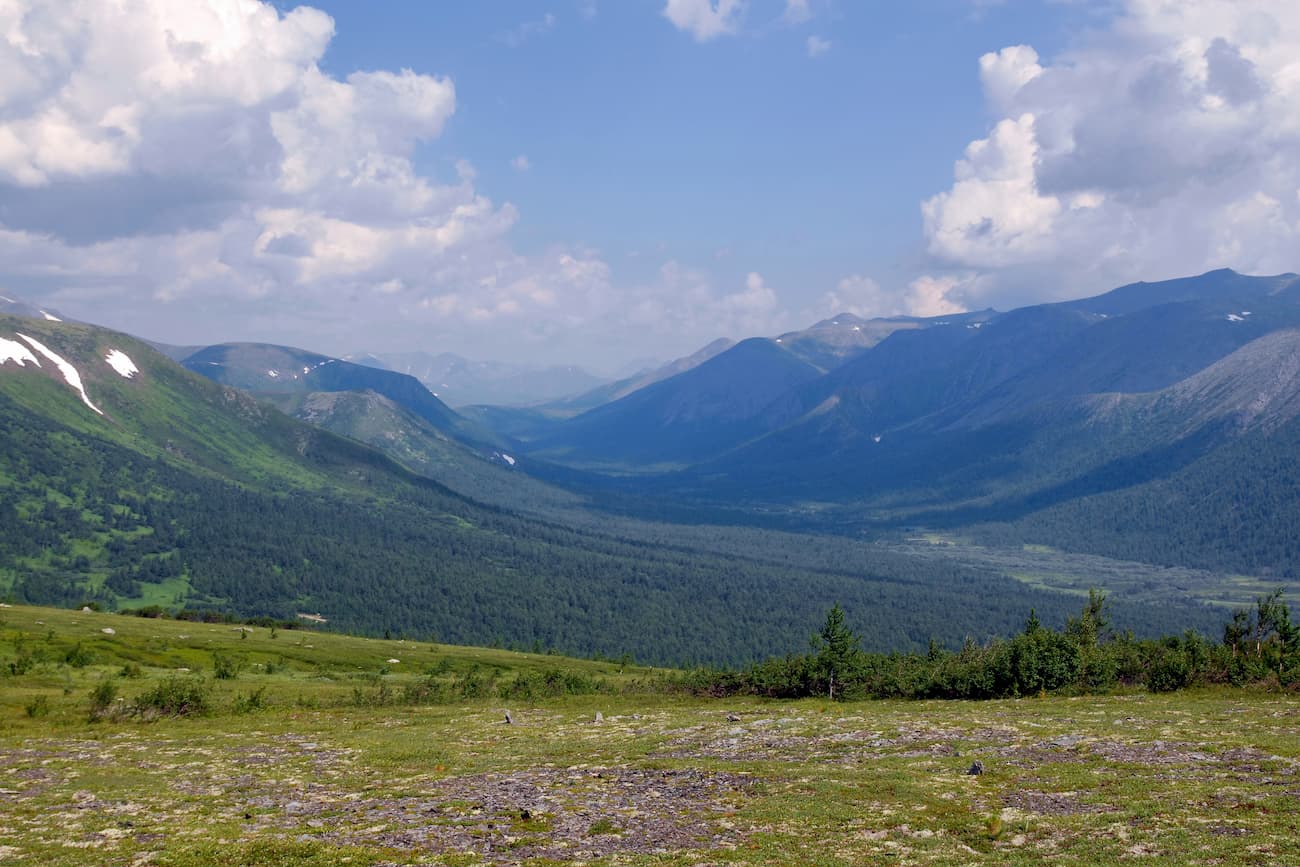
The Khanty-Mansiysk Autonomous Area (KhMAO) was established in 1930. Its name comes from two main northern indigenous peoples – the Khanty and the Mansi. From 1944 it was legally part of the Tyumen Region , but in 1993 the Area received autonomy and became a full-fledged territorial entity of the Russian Federation. It is a part of the Urals Federal District. The administrative centre is the city of Khanty-Mansiysk , whereas the largest city is Surgut. The word Yugra was introduced to the name of the Khanty-Mansiysk Autonomous Area in 2003 to pay tribute to the old name used by the locals to call the territories lying beyond the North Urals.
The KhMAO borders the Komi Republic in the north-west, the Yamalo-Nenets Autonomous District in the north, the Krasnoyarsk Area and the Tomsk Region in the east and south-east, the Tyumen Region in the south and the Sverdlovsk Region in the south-west.
The area of the territory is 534,801 sq.km, the length from north to south is 800 km, from west to east is 1400 km. The population of this huge territory is 1,674,676 people as of 2020, which is the same amount as people living in Barcelona or Munich.
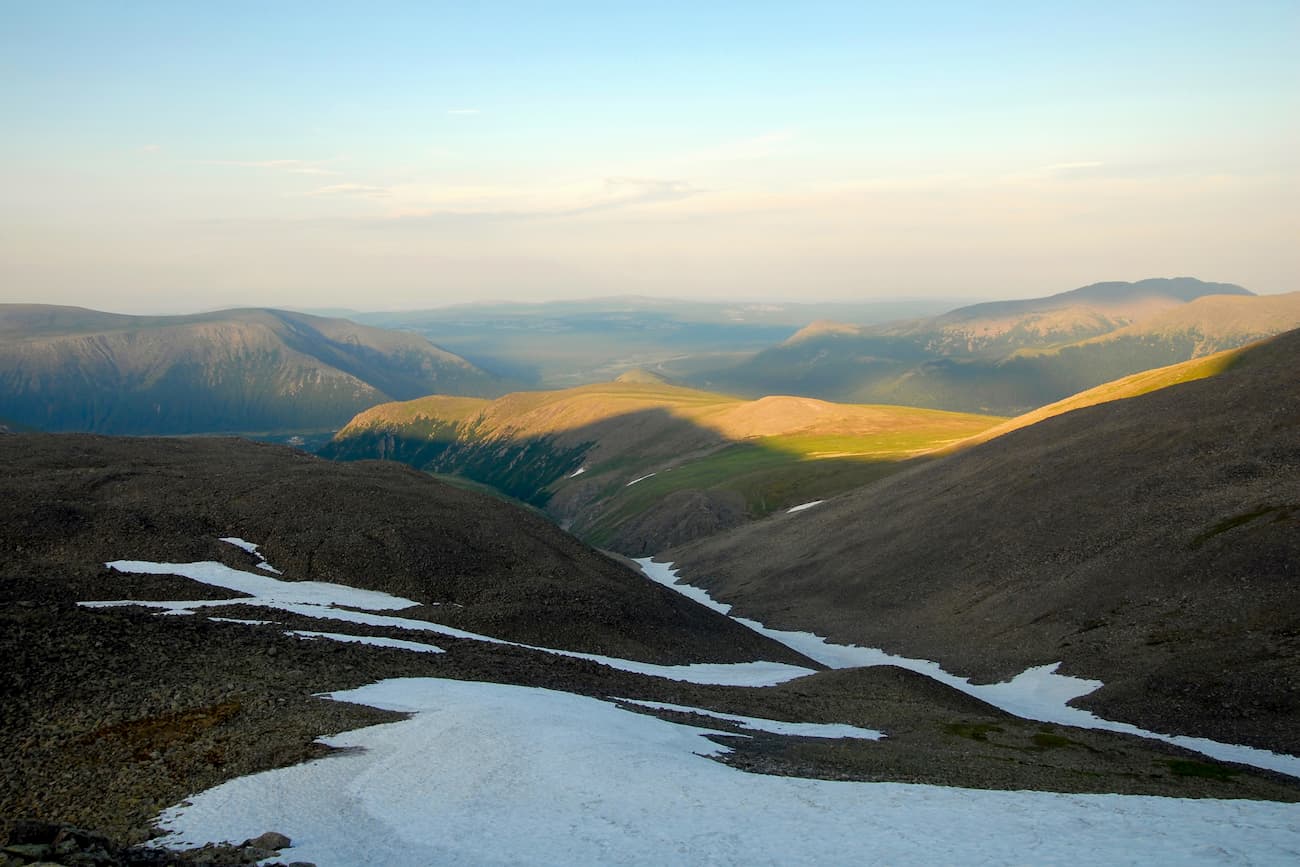
The main part of the territory is a huge, poorly dissected plain where absolute elevation marks rarely exceed 200 meters above sea level. The western part of the KhMAO territory is characterized by low and middle mountainous terrains with some Alpine relief featured in the Subpolar Urals. Here are ridges and spurs of the mountain system of the North Urals and the Subpolar Urals. The maximum absolute elevations are on the border with the Komi Republic . Mount Narodnaya (1,895m) is the highest peak.
More than 800 species of higher plants grow in the Khanty-Mansi Autonomous Area . Almost the entire territory is covered by taiga forests that occupy about 52% of the area. Spruce, fir, pine, cedar, larch, birch, alder grow here. In the northern parts of the area, the composition of the vegetation is greatly influenced by perennial permafrost. Light lichen grasslands which are used as deer pastures are widespread there. Tundra dominates in the mountainous and hilly areas. River floodplains and lowlands are characterized by meadow vegetation, the so-called water meadows. High floodplains of large rivers are mainly covered with woods that mainly feature willows, birches and aspens. Forests and swamps are rich in berries and various valuable plants, most of which are used in traditional indigenous medicine.
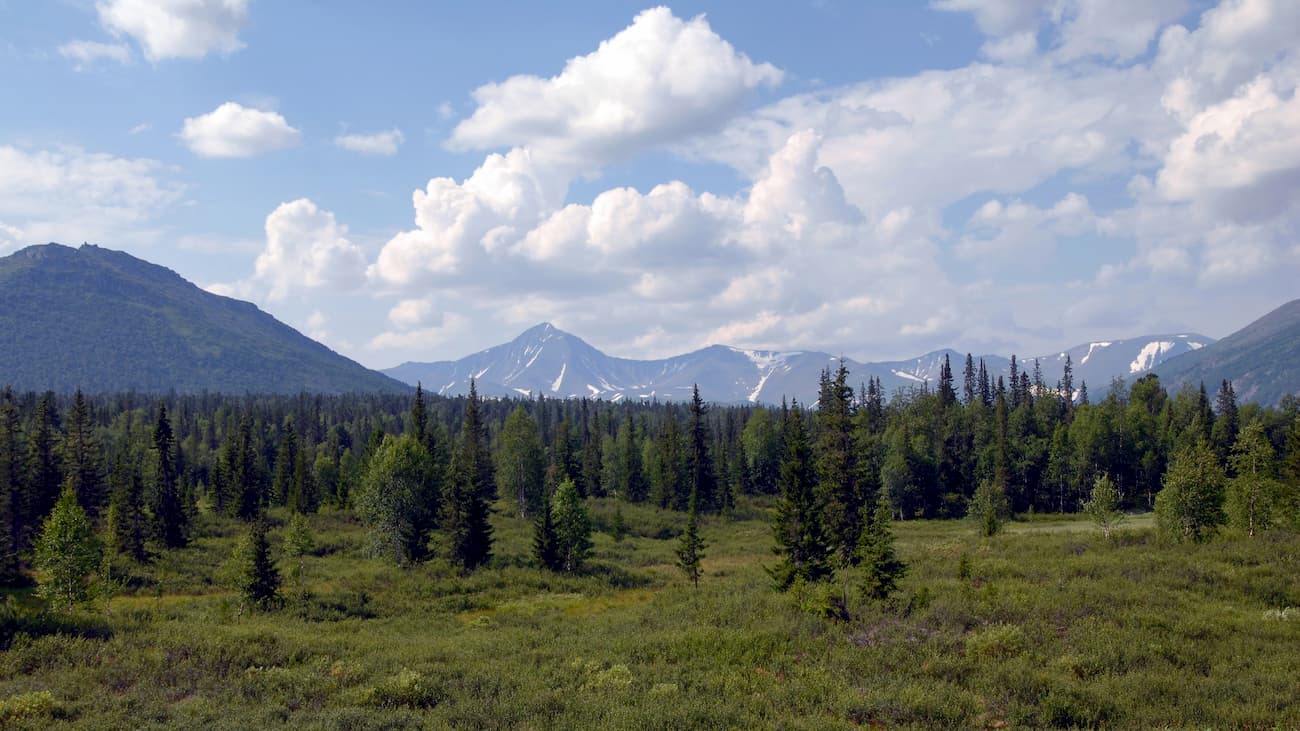
The animal world is typical for the Russian taiga zone. There are 369 species of vertebrates. Mammals are represented by 60 species (28 of them are commercial species). The most common and valuable of them are wild reindeer, elk, fox, sable, fox, squirrel, marten, ermine, Siberian weasel, polecat, mink, weasel, otter, hare and others. Wolverine and West Siberian river beaver are included in the Red Book of Russia.
There are 256 bird species in the region, including 206 sedentary and nesting species. Some rare bird species are listed in the Red Book. There are 42 species of fish in rivers and lakes. Of these, 19 species are commercial, among them are starlet sturgeon, lelema, muksun (whitefish), pelyad, chir, lake herring, wader, tugun, freshwater cod, pike, ide, roach, bream, fir, perch, ruff, golden and silver crucian carp, carp (carp is grown in the cooling ponds of the Surgutskaya and Nizhnevartovskaya hydroelectric plants). Sturgeon is listed in the Red Book. There is an abundance of mosquitoes and gnats in the area, the greatest activity of which is in the second half of summer.
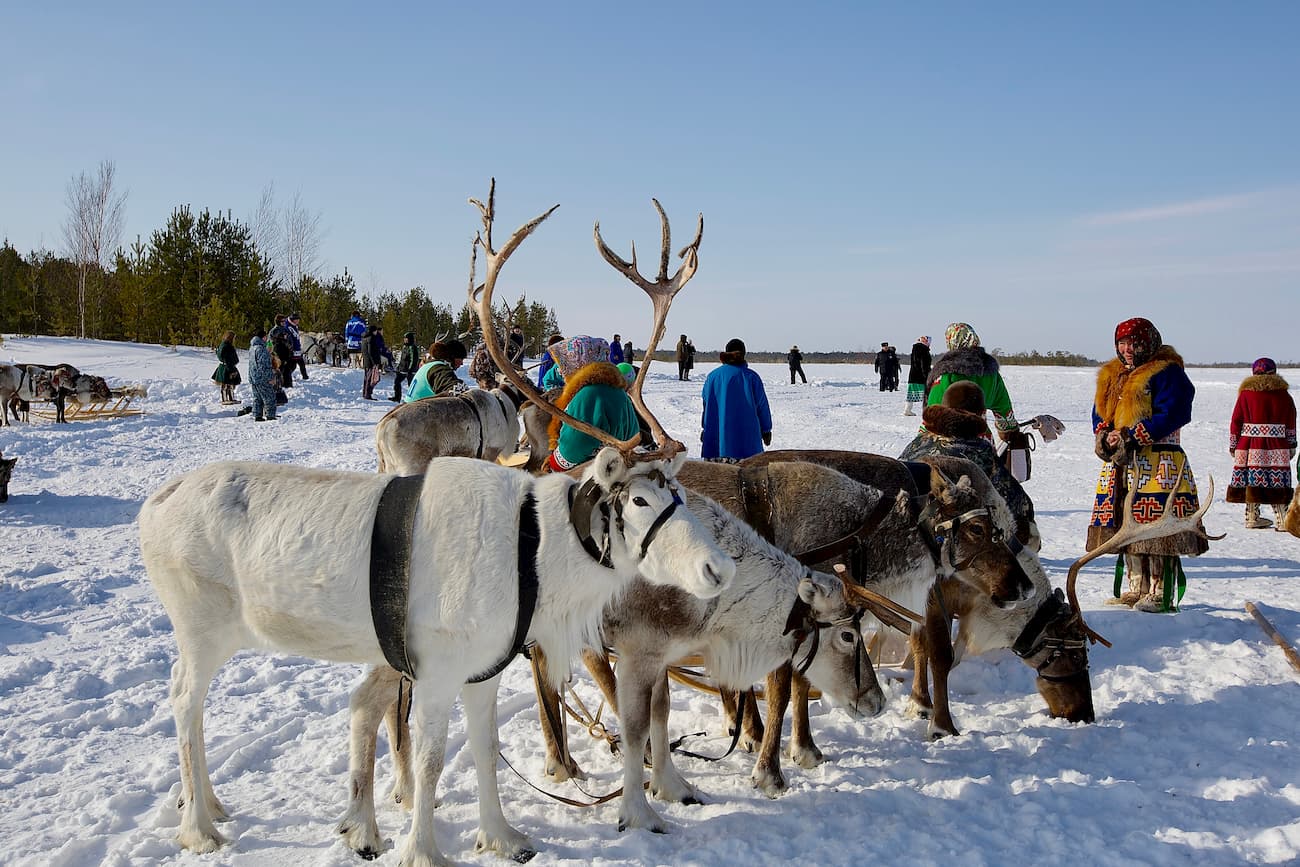
Yugra can boast of over 2 thousand large and small rivers, the total length of which is 172,000 km. The main rivers are the Ob (3,650 km), the Irtysh (3,580 km). These are some of the largest rivers in Russia. Other significant rivers include the tributaries of the Ob (the Vakh, Agan, Tromyogan, Bolshoy Yugan, Lyamin, Pim, Bolshoy Salym, Nazym, Severnaya Sosva, Kazym rivers), the tributary of the Irtysh (the Konda River) and the Sogom River. Ten rivers are over 500 km long. All the Yugra rivers with the exception of the rivers in the Ural part of the region are characterized by rather slow currents, gentle slopes, some surge wave phenomena, spring and summer floods. The Ob River basin extends over a distance of 700-200 km from the mouths of its tributaries. Such abundance of water facilitates the appearance of floodplain swamps and seasonal lakes.
The region's swamps are predominantly of the upper and transitional type. Those water basins occupy about a third of the region. About 290,000 lakes with the area of more than 1 ha are surrounded by swamps and forests. The largest lakes are Tursuntsky Tuman, Levushinsky Tuman, Vandemtor and Trmemtor. The deepest lakes are Kintus (48 m) and Syrky Sor (42 m). However, most of the lakes (about 90%) are modest and quite small and have no surface runoff.
The area is rich in resources of fresh, mineral and thermal underground waters, which are still insignificantly used.
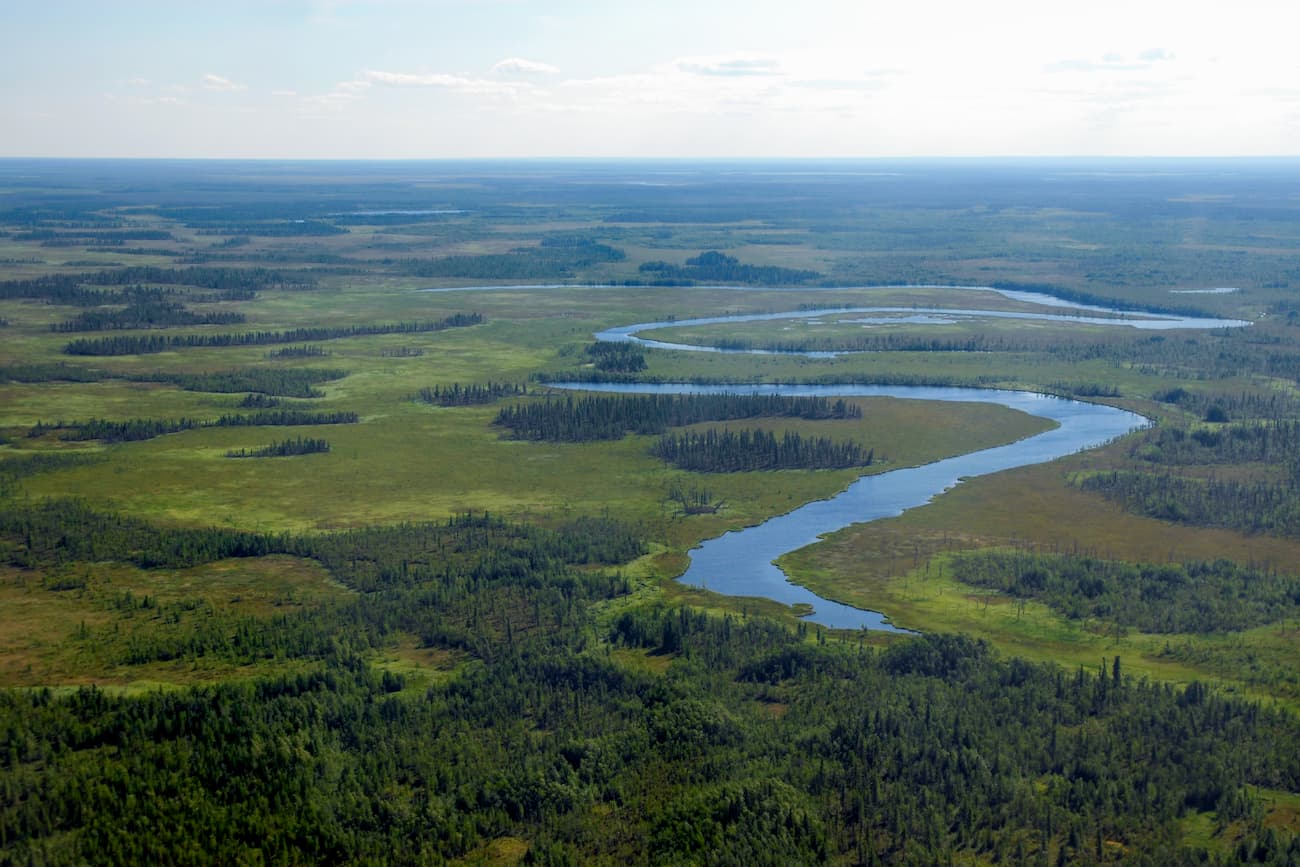
The climate is moderately continental. Winters are harsh, snowy and long, and summers are short and relatively warm. The territory is protected from the west by the Ural Mountains but its openness from the north has a significant impact on the climate formation because cold air masses from the Arctic freely penetrate the area. The flat character of the terrain with a large number of rivers, lakes and swamps also has its impact. Most of the precipitation falls during the warm seasons. But even with a small amount of precipitation, their evaporation is very low, which as a result contributes to the formation of the zone of excessive moisture throughout the Yugra. The snow cover is stable from late October to early May, its height varies from 50 to 80 cm. The region is characterized by a rapid change of weather conditions, especially in transitional seasons (autumn and spring), as well as during the day. Late spring and early autumn frosts are rather frequent and can happen even until mid-June. Average January temperatures range from -18ºC to -24ºC (0 F to -11 F) and can reach -60ºC to -62ºC (-76 F to -80 F) when the northern cold air masses break through. The average temperature in July, the warmest month of the year, ranges from +15ºC to +20ºC (+59 F to +68 F) and on very rare days can reach a maximum temperature of +36ºC (+97 F). The prevailing wind direction is north in summer and south in winter.
The weather in the mountains is quite changeable and cool even in summer. The best time to visit the region's mountains is between July and mid-August.
The Yugra of the Khanty-Mansi Autonomous Area has a huge natural resource potential. These are oil and gas deposits, forests, gold and iron ore deposits, as well as bauxites, copper, zinc, lead, niobium, tantalum, brown and hard coal deposits, rock crystal, quartz and piezo quartz, peat deposits, etc. The region has plenty of natural resources. In terms of natural gas reserves, the Yugra ranks second in the Russian Federation after the Yamalo-Nenets Autonomous District .
The industry is dominated by oil and gas production, power generation and processing industries, including woodworking except for pulp and paper production.
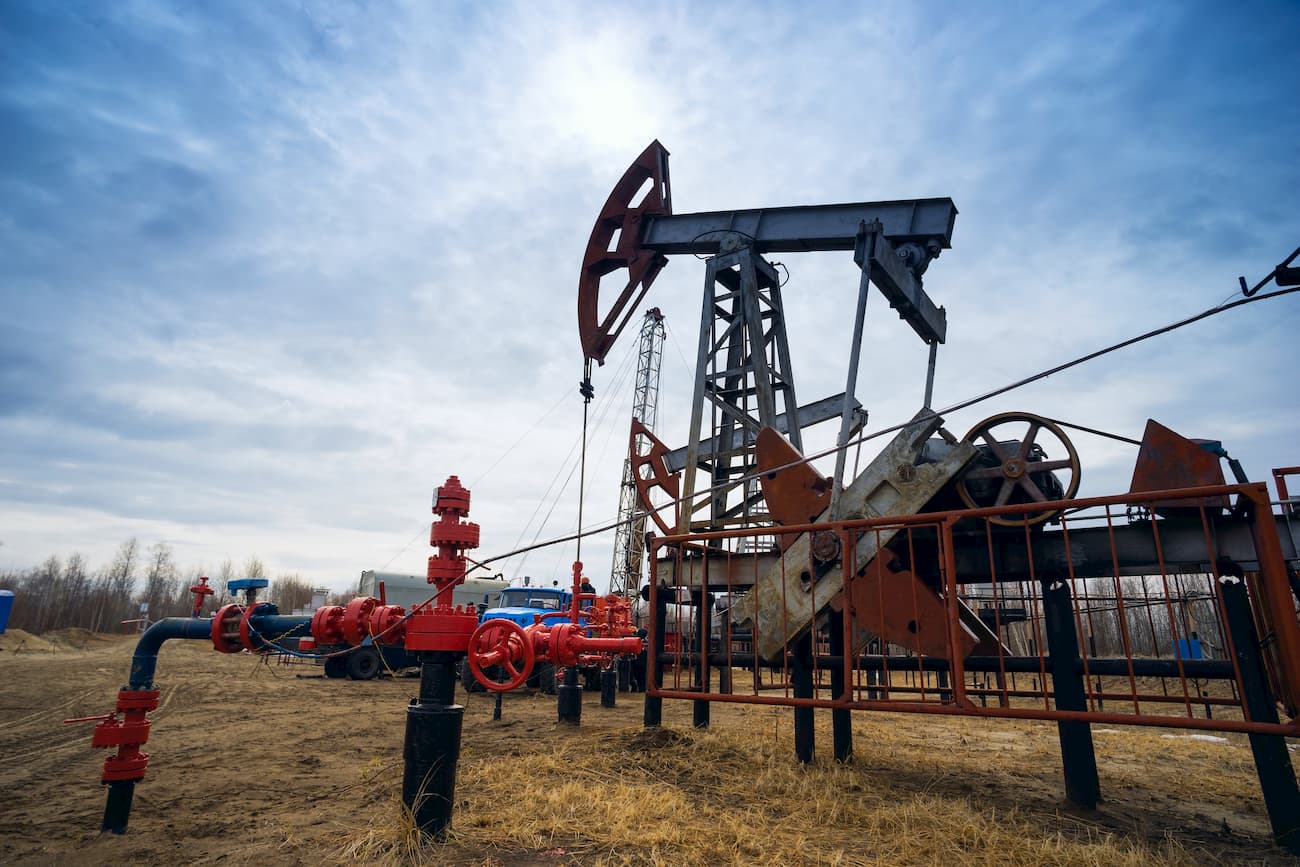
The Khanty-Mansi area has very developed tourism of all kinds. There is a modern infrastructure for cultural exploration as well as for active recreation.
Fans of sports and eco-friendly tourism will be able to conquer majestic mountains and raft down picturesque rivers, enjoy the beauty of nature in nature reserves and natural parks. The hills and mountains of this area open up endless opportunities for skiing and snowboarding.
The mountainous part of the Subpolar Urals located on the territory of the Khanty-Mansi Autonomous Area is very beautiful. The highest peaks of the Ural Mountains are situated here.
Being the highest point of the whole Urals, Mount Narodnaya (1,895 m), also known as Naroda and Poenurr and translated as People's Mountain is territorially situated in the Subpolar Urals, on the border of the Yugra Area and the Komi Republic . It is the highest point in European Russia outside the Caucasus. This leads to its large topographic prominence of 1,772 metres (5,814 ft).
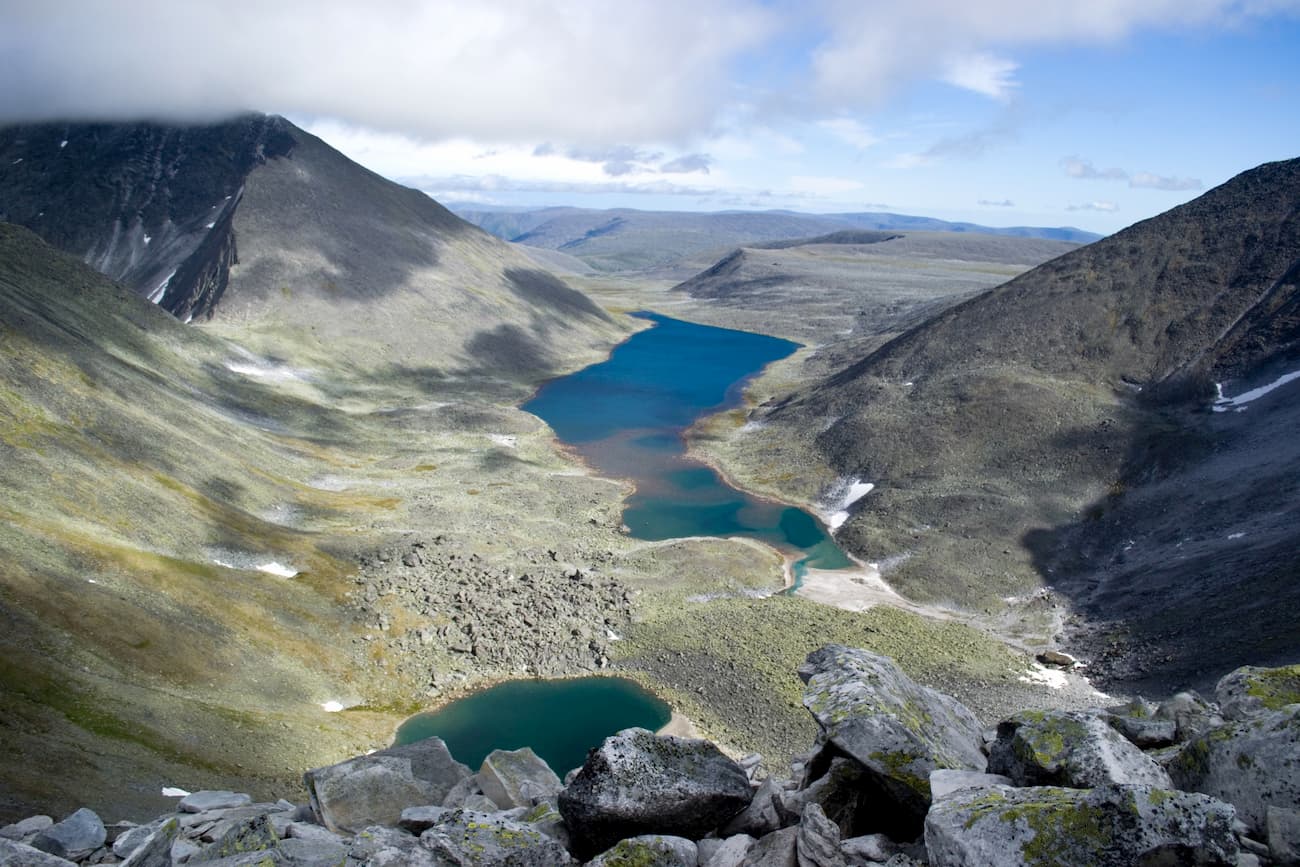
The top of the mountain is half a kilometre from the border towards Yugra. As for the name of the mountain, scientists could not come to a common opinion for a long time, so there are two versions. According to one version, in the Soviet years, an expedition of pioneers gave the mountain a name in honour of the Soviet people - Narodnaya (the stress is on the second syllable). According to the other version, even before the arrival of the first Soviet tourists, the peak was named after the River Naroda (the stress is on the first syllable) flowing at the foot of the mountain. The Nenets peoples called the River Naroda Naro, which means a thicket or a dense forest, and the Mansi peoples called it Poengurr or Poen-urr, which translates as the top, or head. The maps used to refer to it as Mount Naroda or Mount Naroda-Iz. Nowadays, it appears everywhere as Narodnaya.
In the 1980s, someone set a bust of Lenin on the top of the mountain. Its remains can be found there to this day. There is one more symbolic relic there – some Orthodox believers erected a worship cross on top of Mount Narodnaya after a Procession of the Cross.
The slopes of the mountain are steeper in the north-east and south-west and there are many steep rocks on them. The south-eastern and northern parts of the mountain are more gentle but they are also covered with scree. Be vigilant and careful when climbing! On the slopes of the mountain, there are many not only boulders but also caverns filled with clear water as well as ice. There are glaciers and snowfields. From the north-eastern part of the mountain, you can observe Lake Blue near which tourists and travellers like to make bivouacs.
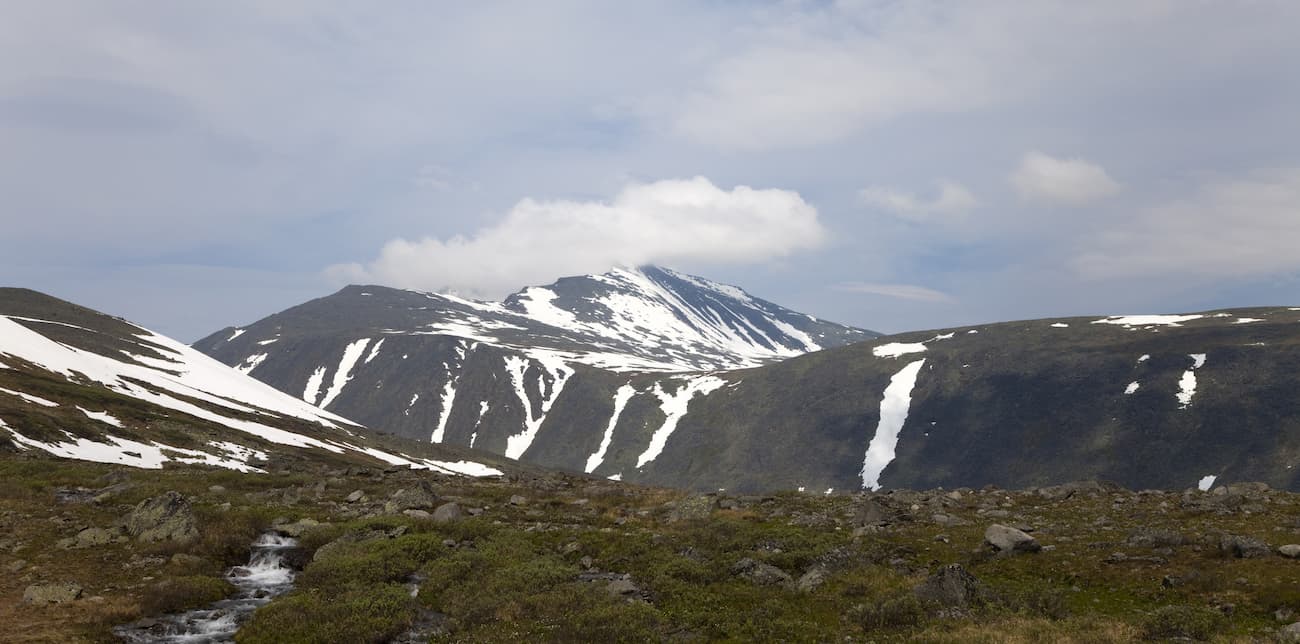
Mesmerizing with its beauty and inaccessibility, it attracts many tourists and fans of active recreation. This majestic mountain is quite remote from the settlements, so getting to it is not an easy task. The mountain is located in the Yugyd Va National Park , so it is necessary to register in advance and get a visit permit from the park administration. How to get to the park administration and get a permit, read the article on the Yugyd Va National Park .
Mountain Zaschita (1,808 m) is the second-highest peak in the Ural Mountains, after Mount Narodnaya . Mysteriously, the name of the mountain, which roughly translates as Defense or Protection Mount, does not correlate in any way with the Mansi names of the nearby mountains and rivers. The origin of the name is unknown. There are some speculations but we will consider just one of them. On the map of the Northern Urals which was made by the Hungarian researcher Reguli the closest peak to Mount Narodnaya was called gnetying olu. Its location coincides with that of the present-day Mount Zaschita . The name gnetying olu in the Mansi can be deciphered as a mountain on which there is some help from ice. The mountain is believed to protect deer grazing on glaciers from mosquitoes. So, early topographers called the mountain more briefly – Mount Defense. Indeed, the slopes of this mountain are covered with a lot of snow and glaciers (the Yugra, Naroda, Kosyu, Hobyu glaciers and others). And it is here that the Mansi shepherds bring their deer which can rest on glaciers and snow. Summarizing all the above, we can say that Zaschita Mount is to some extent protection for deer from mosquitoes. The very name Zaschita appeared on maps with the beginning of hiking tours in the Subpolar Urals.
Mount Neroyka (1,645 m) is 100 km from Neroyka village, the closest tourist base to this peak. In the 1950s, people who were engaged in quartz mining near the mountain worked and lived in this base. Later, a gravel road was built from the village of Saranpaul to the mountain for large-scale development of the quartz deposit. In recent years, the road has not been much used and is practically not cleaned from snow in winter. There has been a plant built 20 km down from the mountain for primary processing of quartz with the use of nanotechnologies. There is an annual big camping event near the mountain. It is organized by the Tourism Department of the Khanty-Mansi Autonomous Area. You can have a 1-hour helicopter ride to the mountain from the village of Saranpaul. Should you wish to fly from the city of Khanty-Mansiysk , be prepared to fly over the taiga for 2.5-3 hours.
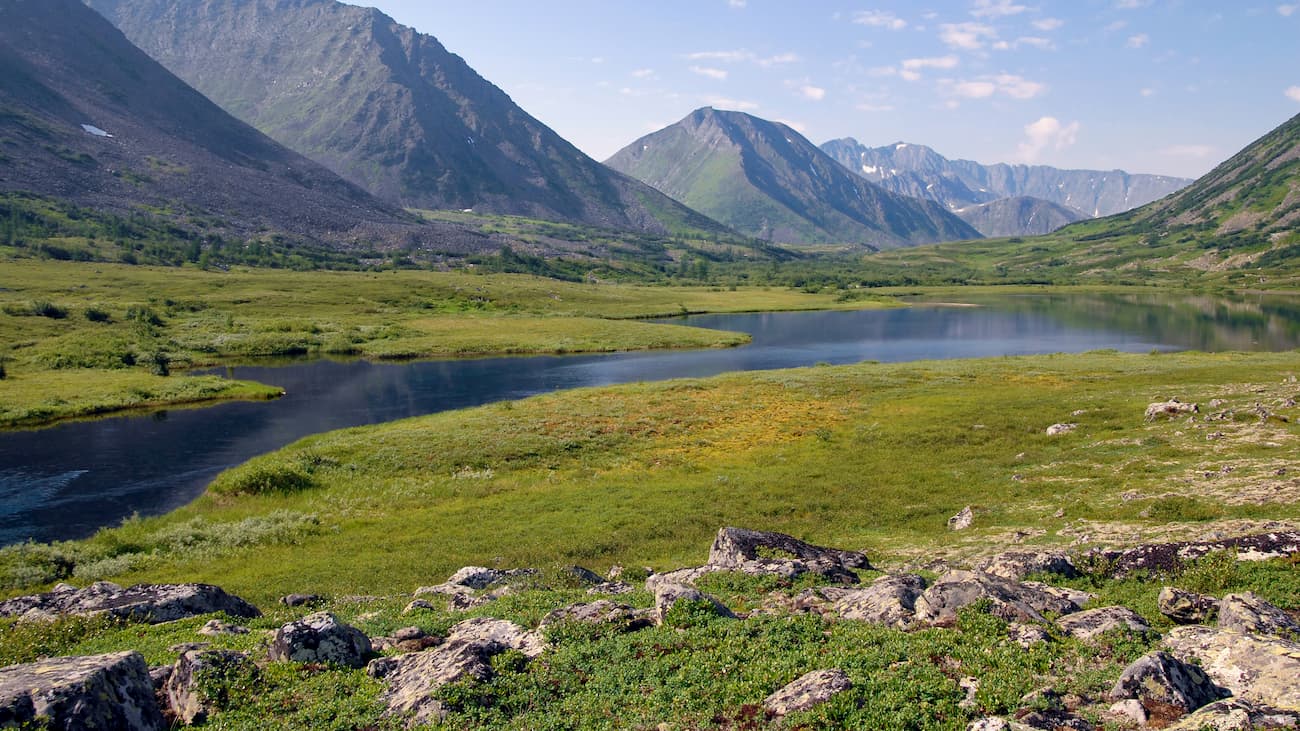
Quite inquisitive tourists happened to discover, by a lucky chance, a Pyramid similar to that of Cheops but four times bigger. It is located on the territory of the Narodo-Ityinsky Ridge. The closest to the pyramid is the village of Saranpaul. The sizes of the found pyramid are as follows: the height is 774 m, in comparison to the Egyptian pyramid which is 147 m; the length of a lateral edge is 230 m whereas the Egyptian pyramid is 1 km. The pyramid is located precisely according to the cardinal directions, there is not a single degree deviation at that. The origin of the pyramid is unknown, scientists are still making assumptions. No traces of human activity were found near the pyramid. The only way to get here at this time is by helicopter.
Samarovskaya Mountain is another wonder that is baffling many people. It is dividing the city of Khanty-Mansiysk into northern and southern parts. Few now living residents know that in the old days the highest part of the modern city used to bear a plural name of the Samarovsky Mountains among which there were Mount Palenina, Komissarskaya, Miroslavskaya, Filinova, and Romanova. Originally, there was a village called Samarovo amidst these mountains. Until now, many issues bewilder both residents and scientists. How could a mountain form in the middle of the West Siberian Plain? What is inside it? Won't the weight of the buildings erected on the top of the mountain affect its height? The uniqueness of Samarovskaya Mountain is that it consists of numerous large stones, boulders, rocks that are absolutely foreign to this area. Scientists have not yet come to a consensus on the mountain’s origin.
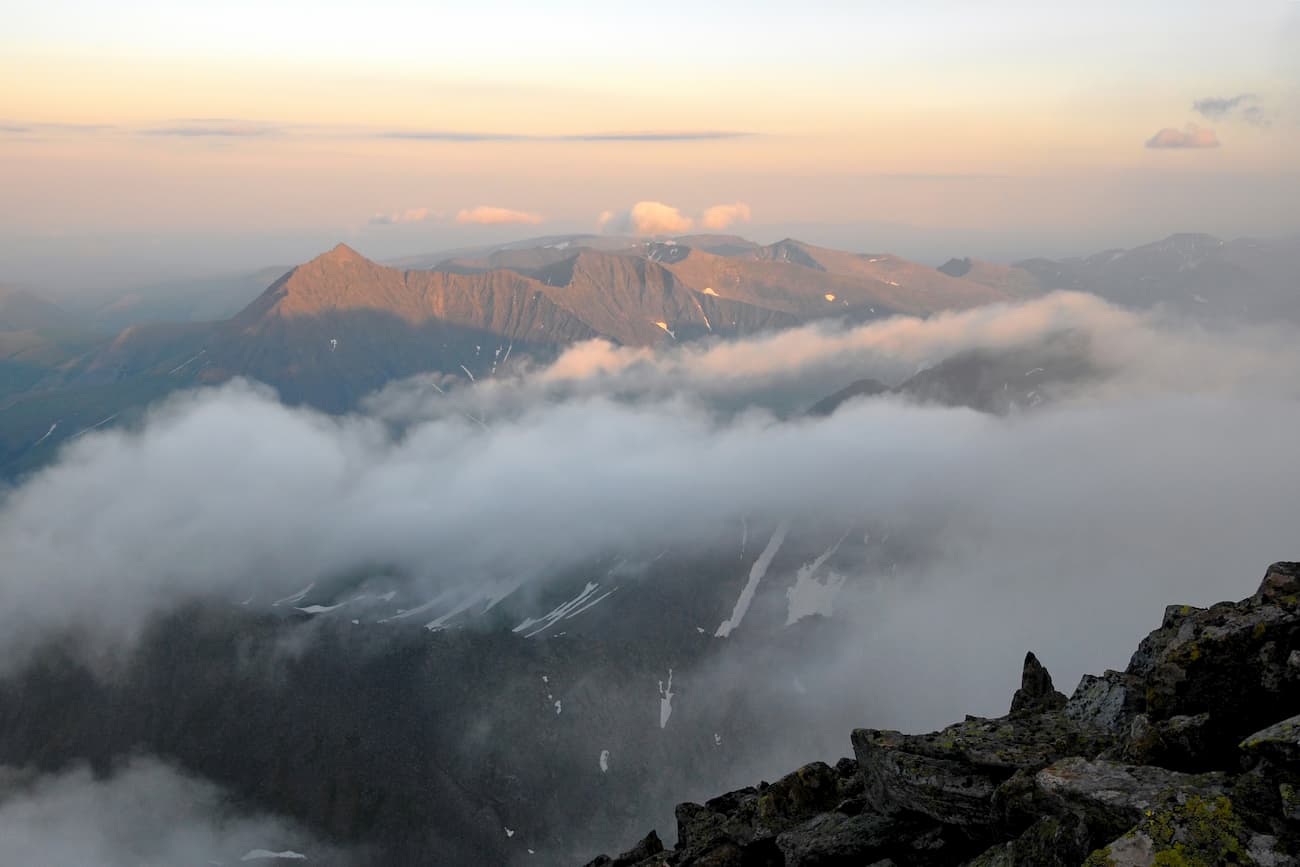
The Yugra is very famous for its ski resorts, the main of which are:
- The Cedar Ravine ski resort (Surgut city, Naberezhny Ave. 39/1)
- Three Mountains (Trekhgorie) ski resort (30 km from Nizhnevartovsk, Ermakovsky settlement)
- Stone Cape (Kamenniy Mys) ski resort (near the city of Surgut)
- Pine Urman ski resort ( Khanty-Mansiysk , Sportivnaya Str., 24)
The far-away lands of the Yugra are the blessed sanctuaries for many animals as the area is rather hostile to a human There are reserves, natural parks, wildlife sanctuaries here that aim to protect the national treasures of the lands. Having visited these regions once, you would crave for coming back again and again to feel that unique sense of unity with nature, to forget about the urban fuss and and hustles whatsoever. The harsh but beautiful nature of this extraordinary area leaves an indelible trace in the soul of every person.
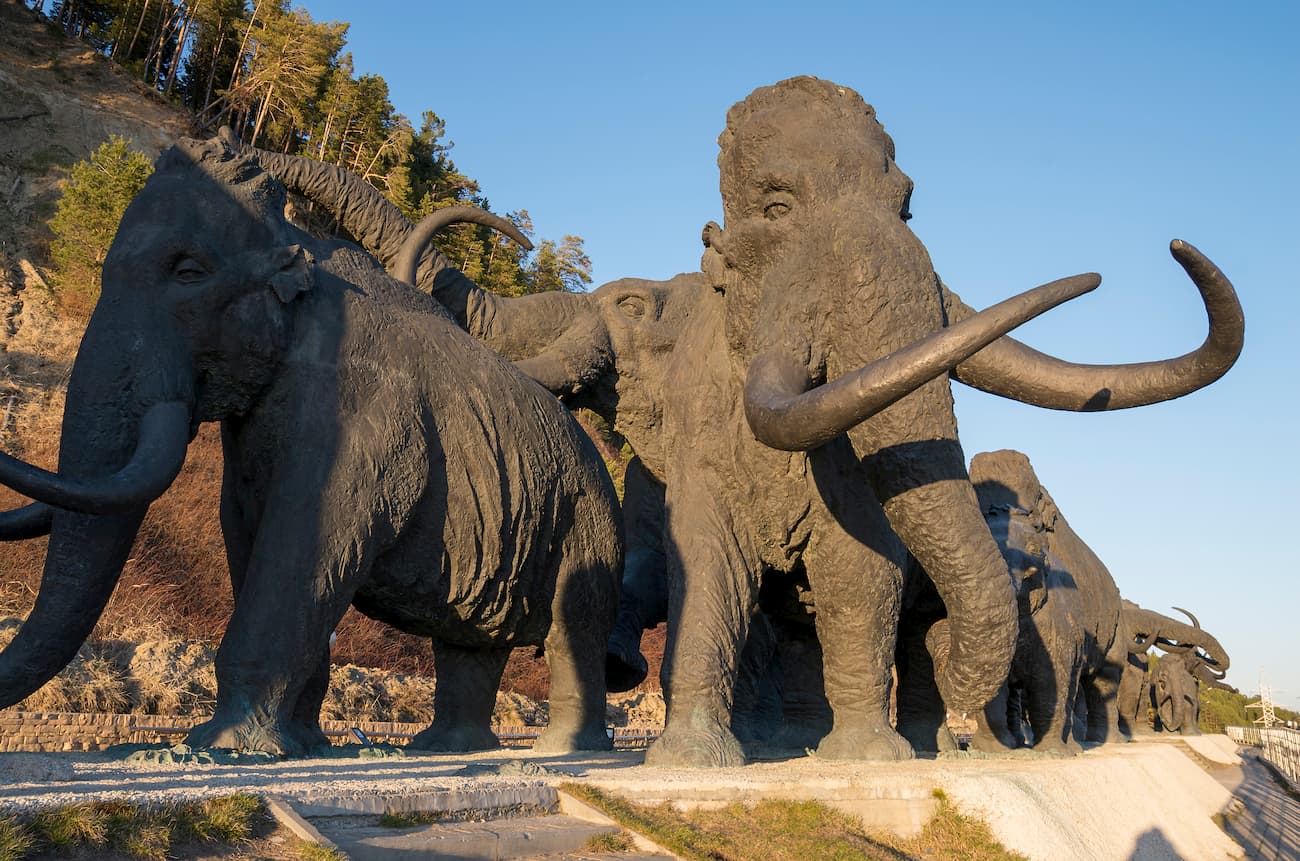
On the territory of the district there are 25 specially protected natural areas, the most famous of them are:
- The reserves are two: the Malaya Sosva Reserve and the Yugan Reserve, the latter was established in 1982 as the largest reserve of taiga landscapes. The purpose of the reserves was to study unobtrusively and carefully preserve the endemic flora and fauna without disturbing natural processes. Hunting and economic activities are prohibited here, which is important for the preservation of natural ecosystems.
- The natural parks are the Samarovsky Chugas Nature Park, the Siberian Sloping Hills (Uvaly), the Numto (also called Lake Numto), and the Kondinskie Lakes.
These reserves and natural parks offer tourists their own excursion programs to make visiting their territory much more enjoyable and educational.
The Samarovsky Chugas Nature Park is located in the center of Khanty-Mansiysk , on a small hill between the Ob and Irtysh rivers.
The territory of the Siberian Sloping Hills (Uvaly) natural park is 350 km away from the city of Khanty-Mansiysk . You can get there by helicopter or by plane. The office of the park is located at 7a Pionerskaya Street, Nizhnevartovsk.
The Kondinskie Lakes Natural Park is located 380 km from Khanty-Mansiysk . Half of the park is covered with swamps, but there is also a recreational area. There you can rest, swim, do some amateur fishing, picking berries (cowberries, cranberries) and mushrooms is permitted. There is only one independent walking route here, it runs for 3 km in the deep forest. It is a cool place for kids since the park is equipped with sports grounds, a pool and a small zoo where the kids can interact with brown bear cubs. What else, try the TaiPark, it is a rope course running at the height of 2.5 meters, having 15 stages, the full length is 125 meters. There is an opportunity to order water walking tours in the town of Sovetsky, which can be reached by train from Khanty-Mansiysk .
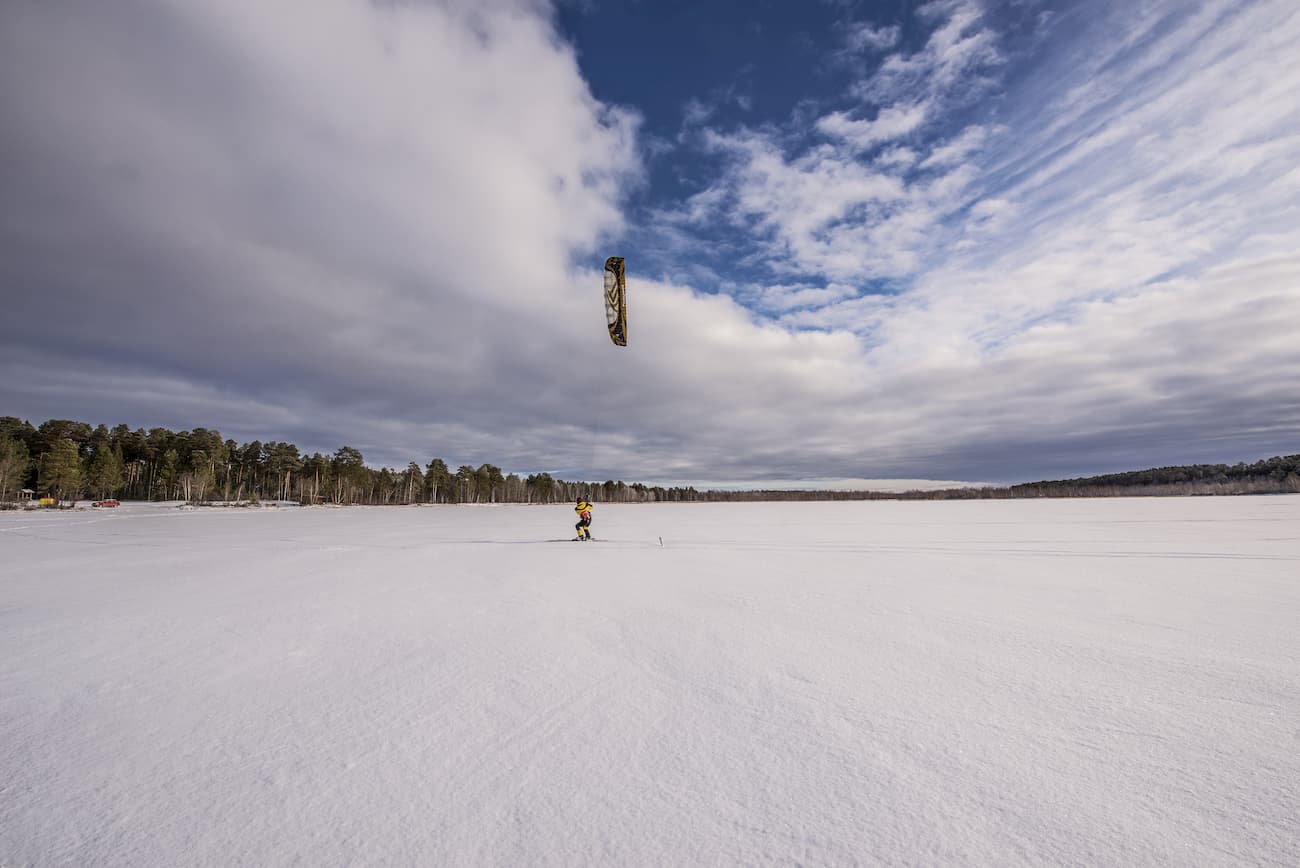
The Numto Nature Park is located almost in the center of the West Siberian Plain, in the Beloyarsk district of the Khanty-Mansi Autonomous Area, 300 km from the city of Surgut and 200 km from the town of Beloyarsk. It is located on the border of Yugra and Yamalo-Nenets Autonomous Area. The administration of the park is located at 2, Beloyarsky micro-district, 4a. The territory of the natural park is a treasure trove of archaeological and ethnocultural monuments. As of today, there have been discovered 20 architectural monuments, including fortified and not fortified settlements, places of worship abandoned by the peoples who lived here from the Stone Age to almost the present day. Researchers have also found 65 monuments of ethnic value, the main of which are worship objects, sacred places and cemeteries.
The Malaya Sosva Reserve includes several subordinated territories and sanctuaries, including Lake Ranghe-Tour. The reserve offers a 4-km walking guided route that gets the visitors introduced to the typical features and characteristics of flora and fauna of the region. The route is called Bear Trail and you can spot bears there (don’t come close though, we’ve already written how to behave if you meet a bear in the wild). Also, you will see the River Malaya Sosva, some marshes, ancient cultural monuments and other nice sights. Permission to visit the reserve can be obtained from the administration of the reserve at Lenina Str. 46, town Sovetskiy.
As to the Yugan Nature Reserve , it is inaccessible to common hikers who are afraid of flying since there are no roads to it. The only way to get there is taking a helicopter ride. You also must obtain a permit in the administration of the reserve, go accompanied by employees of the reserve, and only on special transport of the reserve (motorboat, snowmobile). The central manor of the Reserve and the administration are located in the village of Ugut. To get to this village, you should first go to the town of Surgut, then go to the town of Pyt-Yakh, and from it there is a road to the village of Ugut. It is about 100 km from Ugut to the southern border of the reserve i, and another 25 km to the nearest cordon. The administration works from Monday to Friday. You can request a permit via mail at [email protected] , order a guided tour at [email protected]
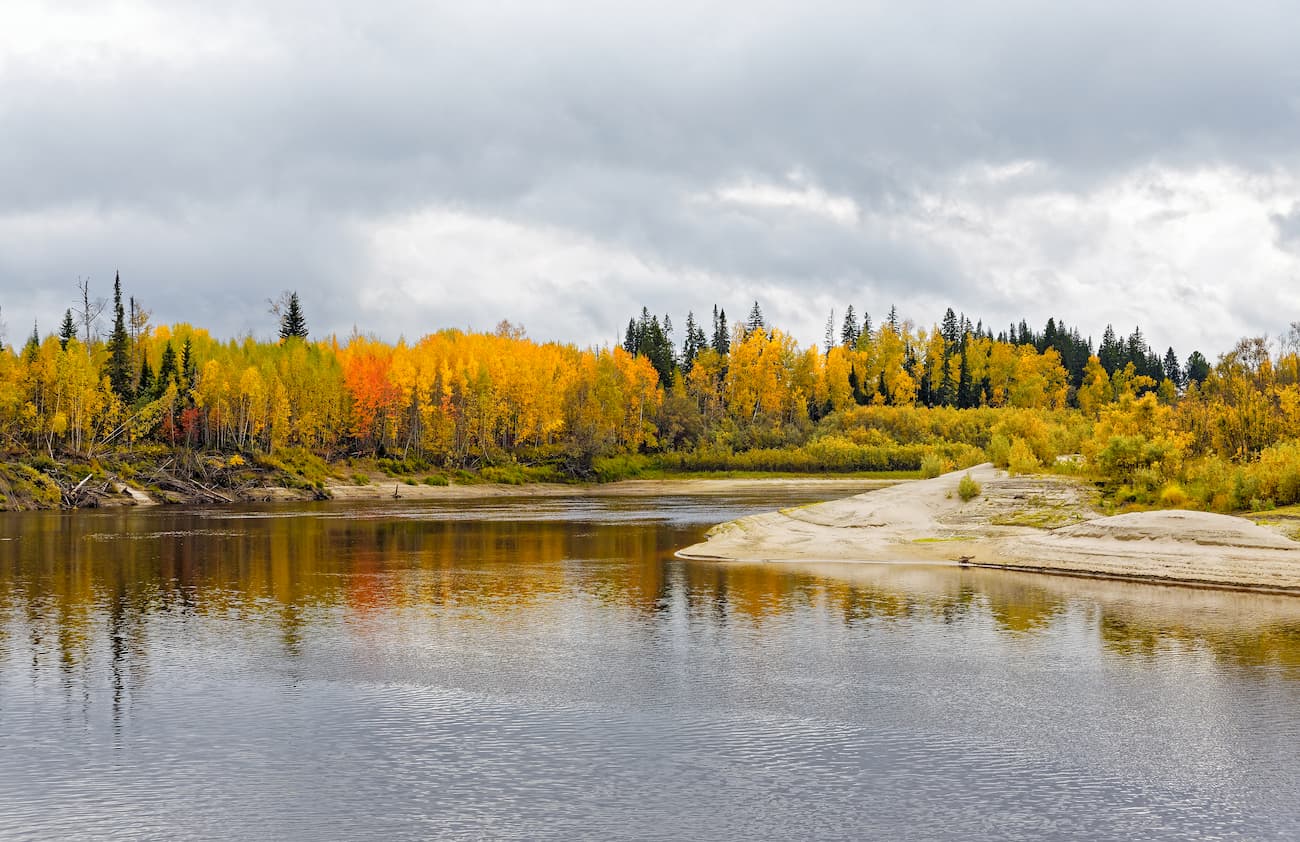
The Yugra lands are heaven for water sports aficionados. They can have some awesome fishing or go rafting along such rivers as: the river Naroda, the Deep Sabun, etc.
The Naroda River is 140 km long. It is the left tributary of the Manya River located in the Ob River basin. The river has its origin on the south-western slope of Mount Narodnaya . It is a mountain-taiga river with rapids, swifts, numerous rolls, which attracts interest among water tourists. However, it is usually not rafted very often.
The Deep Sabun River flows through the territory of the Siberian Sloping Hills Nature Park. The park has developed multi-day water routes. It is possible to raft along the river in summer and to go skiing along it in winter.
The Kondinskie Lakes are a system of lakes along the left bank of the Konda River. The largest lake is the Arantur, with pine forests on the northern side and sandy beaches well equipped for a nice relaxing me-time. The water heats up well in summer. The small river Okunevaya and the river Maly Akh flow into the lake. The Maly Akh comes in on the west side and connects lake Arantur with Lake Pon-Tour. This lake is the richest in fish, and there is also a parking lot for fishermen here. The streams connect Pon-Tour with small lakes Krugloe and Lopukhovoye. When you look at Lopukhovoe lake, you feel as if you have found yourself in a fabulous place: more than half of its surface is covered with white lilies, as well as yellow flowers of the water-beans. Then the river Big Akh, which flows into the river Konda, connects all the lakes into a single system. Along the river there are many archeological monuments such as forts and settlements which have paths to them. The southernmost lake of the park is Ranghe-Tour.
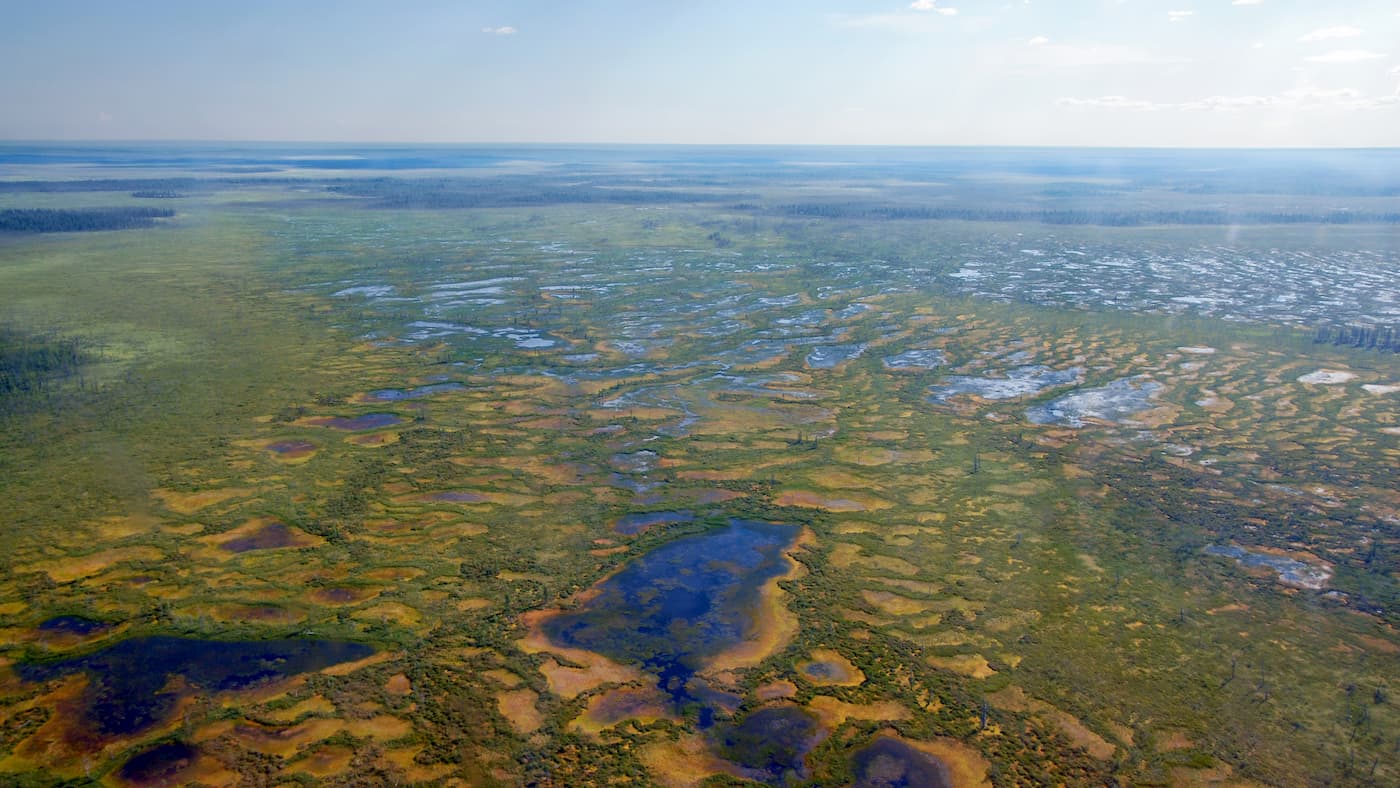
Yugra is not the easiest destination and not the most accessible, but the effort is well worth it. You should first get to the capital of Khanty-Mansiysk Autonomous Area – the city of Khanty-Mansiysk either by air or by train.
Khanty-Mansiysk is based on the premises of the former village Samarovo founded in 1582. It used to be the territory of the Khanty people and a pit stop for coachmen who rode their wagons across the country. The village was founded by Russian Count Samara, thus the name Samarovo. The modern city actually began to develop in 1930 because amidst the Siberian taiga there finally started to appear stone houses on the high bank of the Irtysh River. In 1940, the village was renamed into Khanty-Mansiysk by the name of the peoples living on this territory – the Khanty and the Mansi, and in 1950 it received the status of a town.
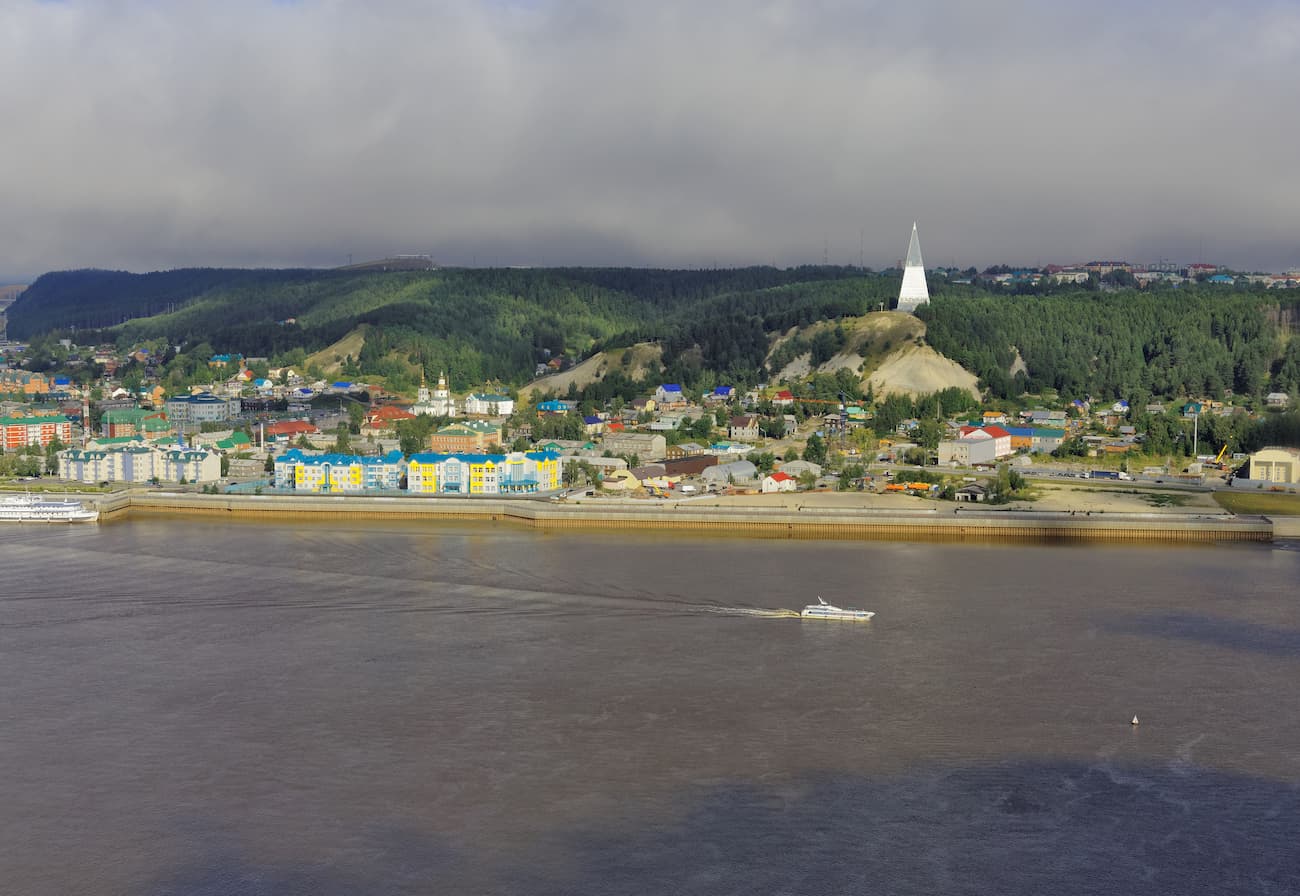
The city has several attractions. Mount Samarovskaya is probably the biggest natural and scientific wonder. It divides the city in two parts and causes many concerns for urban developers who always wonder whether this mountain can move making the buildings slide or even sink in.
Another beauty is the century-old cedar grove that is within the city limits. The grove is a part of the natural park Samarovsky Chugas. The word chugas in the language of the Khanty means a lonely hill in the low river floodplain.

The park is one of the main attractions of the city, it hosts an open-air ethnographic museum called the Torum Maa, a cultural and tourist complex called Archaeopark, a biathlon center. Kids and adults, nature lovers and fans of culture love this place dearly.
A memorial sign to Yugra's discoverers is installed on top of the Samarovsky Chugas. It is a tall stele pyramid divided into three portions. On the lower level, there is a restaurant, on the second level is a small museum, and on the third level there is an observation deck, 40 m above the ground, with a magnificent view of the Irtysh River and the river port. The pyramid is decorated by the bas-relief depicting the discoverers of the region, from the 16th-century Count Samara to the geologists of the 20th century.
Another trademark of Khanty-Mansiysk is the State Museum of Nature and Man. The museum hosts a gallery and a workshop of a famous artist G. Rayshev.
The city has a lot of small monuments generously spread around the city. There is the Khanty family resting on a camp, this monument is near the airport building. You can take a pic at the Golden Tambourine located at the intersection of Gagarin Street and Mira Street. Connoisseurs of culture should also visit the Sun – the Theatre of Ob-Ugrian Peoples, it is the world's first professional theatre of Khanty and Mansi peoples. And if you are travelling with kids, the Khanty-Mansiysk Puppet Theatre is a must-visit. In the period from May to October, you can take a boat ride to the confluence of two rivers – the Ob and the Irtysh. Yugra Service Co. operates such cruises, you can find more information locally at their address Tobolsk Trakt street 4, Khanty-Mansiysk .
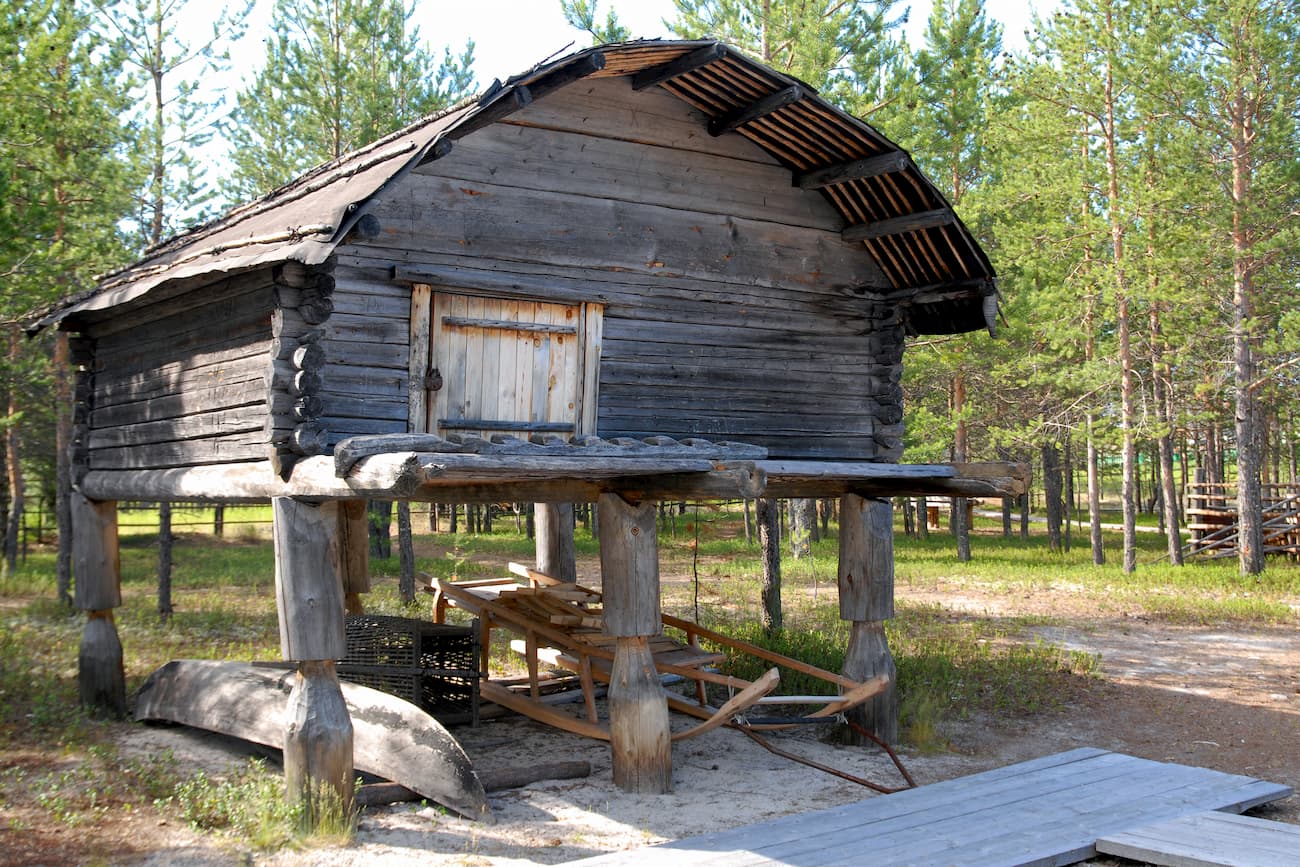
Explore Khanty-Mansiysk Autonomous Okrug – Ugra with the PeakVisor 3D Map and identify its summits .

PeakVisor Hiking Maps
Be a superhero of outdoor navigation with state-of-the-art 3D maps and mountain identification in the palm of your hand!
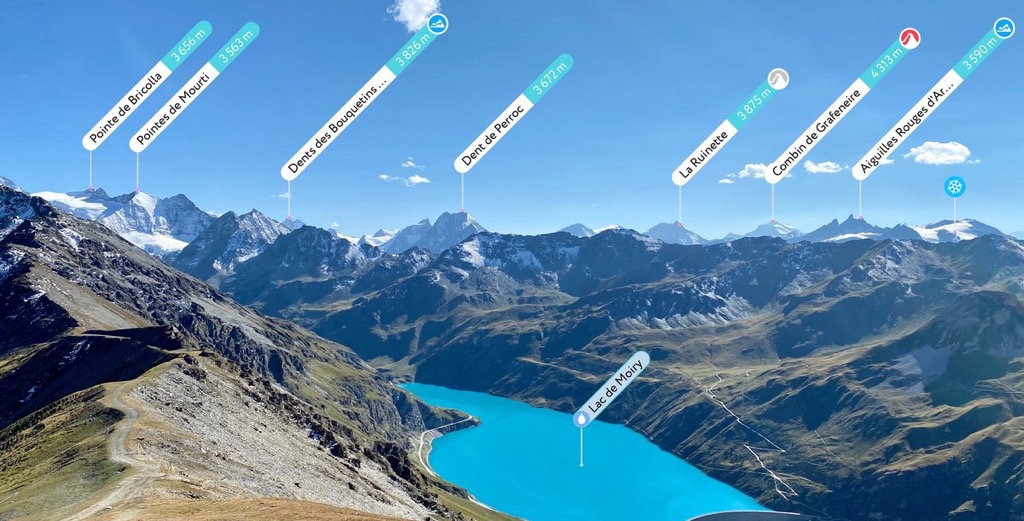
Khanty-Mansi Autonomous Okrug
Khanty-Mansi Autonomous Okrug — Yugra [lower-alpha 1] , commonly shortened to Khantia-Mansia, is a federal subject of Russia (an autonomous okrug of Tyumen Oblast ). It has a population of 1,532,243 as of the 2010 Census . [4] Its administrative center is located at Khanty-Mansiysk .
Administrative divisions
Demographics, settlements, ethnic groups, vital statistics, external links.
The peoples native to the region are the Khanty and the Mansi , known collectively as Ob-Ugric peoples , but today the two groups only constitute 2.5% of the region's population. The local languages, Khanty and Mansi , are part of the Ugric branch of the Finno-Ugric language family, and enjoy a special status in the autonomous okrug. Russian remains the only official language.
In 2012, the majority (51%) [7] of the oil produced in Russia came from Khanty-Mansi Autonomous Okrug, giving the region great economic importance in Russia and the world. It borders Yamalo-Nenets Autonomous Okrug to the north, Komi Republic to the northwest, Sverdlovsk Oblast to the west, Tyumen Oblast to the south, Tomsk Oblast to the south and southeast and Krasnoyarsk Krai in the east.
The okrug was established on December 10, 1930, as Ostyak-Vogul National Okrug ( Остя́ко-Вогу́льский национа́льный о́круг ). In October 1940, it was renamed the Khanty-Mansi National Okrug . In 1977, along with other national okrugs of the Russian SFSR , it became an autonomous okrug (Khanty-Mansi Autonomous Okrug). In 2003, the word " Yugra " was appended to the official name. [8]

The okrug occupies the central part of the West Siberian Plain .
Principal rivers include the Ob and its tributaries Irtysh and Vatinsky Yogan . There are numerous lakes in the okrug, the largest ones are Numto , Tormemtor , Leushinsky Tuman and Tursuntsky Tuman , among others. [9]
The northeasterly line of equal latitude and longitude traverses the Khanty-Mansi Autonomous Okrug.
Population : 1,674,676 (2020); [10] 1,532,243 ( 2010 Russian census ) ; [4] 1,432,817 ( 2002 Census ) ; [11] 1,268,439 ( 1989 Soviet census ) . [12]
Khanty-Mansi Autonomous Okrug has an area of 523,100 km 2 , but the area is sparsely populated. The administrative center is Khanty-Mansiysk , but the largest cities are Surgut , Nizhnevartovsk , and Nefteyugansk .
The Indigenous population ( Khanty , Mansi , Komi , and Nenets ) is only 2.8% of the total population in the Khanty-Mansi Autonomous Okrug. The exploitation of natural gas in Khanty-Mansi Autonomous Okrug has attracted immigrants from all over the former Soviet Union. The 2021 Census counted 17 ethnic groups of more than five thousand persons each. The ethnic composition is as follows:
Population of Khanty-Mansi Autonomous Okrug: [13]
Historical population figures are shown below:

Source: [15]

According to a 2012 survey [16] 38.1% of the population of Yugra adheres to the Russian Orthodox Church , 5% are unaffiliated generic Christians , 1% of the population adheres to the Slavic native faith (Rodnovery) or to Khanty-Mansi native faith. Muslims (mostly Tatars ) constitute 11% of the population. In addition, 23% of the population declares to be spiritual but not religious , 11% is atheist , and 10.9% follows other religions or did not give an answer to the question. [16] According to recent reports Jehovah's Witnesses have been subjected to torture and detention in Surgut. [18]
In Khanty-Mansi Autonomous Okrug, the primary transport of goods is by water and railway transport; 29% is transported by road, and 2% by aviation. The total length of railway tracks is 1,106 km. The length of roads is more than 18,000 km.
- Hockey Club Ugra
- List of Chairmen of the Duma of the Khanty-Mansi Autonomous Okrug
Related Research Articles

Khanty-Mansiysk is a city in west-central Russia. Technically, it is situated on the eastern bank of the Irtysh River, 15 kilometers (9.3 mi) from its confluence with the Ob, in the oil-rich region of Western Siberia. Though it is an independent city, Khanty-Mansiysk also functions as the administrative centre of Khanty-Mansiysky District, and the administrative center of Khanty-Mansi Autonomous Okrug–Yugra.
Nyagan is a town in the northwest of Khanty–Mansi Autonomous Okrug, Russia, located near the Ob River and 230 kilometers (140 mi) northwest of Khanty-Mansiysk. It is named after the Nyagan-Yugan River, a tributary of the Ob River. Population: 63,034 (2021 Census) ; 54,890 (2010 Russian census) ; 52,610 (2002 Census) ; 54,061 (1989 Soviet census) .

Megion is a town in Khanty-Mansi Autonomous Okrug–Yugra, Russia, located at the altitude of 45 meters (148 ft) above sea level, on the right bank of the Ob River, 380 kilometers (240 mi) east of Khanty-Mansiysk and 760 kilometers (470 mi) northeast of Tyumen. The area of the town is 50.51 square kilometers (19.50 sq mi) and the nearest airport is in Nizhnevartovsk. Population: 49,449 (2010 Russian census) ; 46,566 ; 39,783 (1989 Soviet census) .

Yugorsk is a town in Khanty–Mansi Autonomous Okrug, Russia, located in the northwestern part of the East-West lowland, 420 kilometers (260 mi) from Khanty-Mansiysk. Population: 34,067 (2010 Russian census) ; 30,285 (2002 Census) ; 24,928 (1989 Soviet census) .

Sovetsky is a town and the administrative center of Sovetsky District in Khanty-Mansi Autonomous Okrug, Russia, located 470 kilometers (290 mi) west of Khanty-Mansiysk, the administrative center of the autonomous okrug. Population: 26,495 (2010 Russian census) ; 23,230 (2002 Census) ; 21,123 (1989 Soviet census) .
Lyantor is a town in Surgutsky District of Khanty–Mansi Autonomous Okrug, Russia, located on the Pim River, 625 kilometers (388 mi) northeast of Khanty-Mansiysk, the administrative center of the autonomous okrug. Population: 38,992 (2010 Russian census) ; 33,011 (2002 Census) ; 22,071 (1989 Soviet census) .

Pokachi is a town in Khanty–Mansi Autonomous Okrug, Russia, located on the right bank of the Vatyegan River, 350 kilometers (220 mi) east of Khanty-Mansiysk and 800 kilometers (500 mi) northeast of Tyumen. Population: 17,171 (2010 Russian census) ; 17,017 (2002 Census) ; 11,536 (1989 Soviet census) .
Kogalym is a town in Khanty-Mansi Autonomous Okrug, Russia, located on the Inguyagun River 325 kilometres (202 mi) northeast of Khanty-Mansiysk. Population: 58,181 (2010 Russian census) ; 55,367 (2002 Census) ; 44,297 (1989 Soviet census) .

Beloyarsky is a town and the administrative center of Beloyarsky District in Khanty-Mansi Autonomous Okrug, Russia, located on the Kazim River, northwest of Khanty-Mansiysk, the administrative center of the autonomous okrug. Population: 20,283 (2010 Russian census) ; 18,721 (2002 Census) ; 20,534 (1989 Soviet census) .

Raduzhny is a town in Khanty-Mansi Autonomous Okrug, Russia, located on the Agan River, 475 kilometers (295 mi) northeast of Khanty-Mansiysk and 975 kilometers (606 mi) northeast of Tyumen. Population: 43,399 (2010 Russian census) ; 47,060 ; 43,726.

Pyt-Yakh is a town in Khanty–Mansi Autonomous Okrug, Russia, located on the east bank of the Bolshoy Balyk River, southeast of Khanty-Mansiysk. Population: 41,488 (2010 Russian census) ; 41,813 (2002 Census) ; 17,101 (1989 Soviet census) .

Beloyarsky District is an administrative and municipal district (raion), one of the nine in Khanty-Mansi Autonomous Okrug of Tyumen Oblast, Russia. It is located in the north of the autonomous okrug. The area of the district is 41,574 square kilometers (16,052 sq mi). Its administrative center is the town of Beloyarsky. Population: 9,766 ; 9,493 (2002 Census) ; 8,927 (1989 Soviet census) .

Khanty-Mansiysky District is an administrative and municipal district (raion), one of the nine in Khanty-Mansi Autonomous Okrug, Russia. It is located in the center of the autonomous okrug. The area of the district is 46,400 square kilometers (17,900 sq mi). Its administrative center is the town of Khanty-Mansiysk. As of the 2010 Census, the total population of the district was 19,362.

Kondinsky District is an administrative and municipal district (raion), one of the nine in Khanty-Mansi Autonomous Okrug of Tyumen Oblast, Russia. It is located in the south of the autonomous okrug. The district is 55,170 square kilometers (21,300 sq mi). Its administrative center is the urban locality of Mezhdurechensky. Population: 34,494 ; 35,018 (2002 Census) ; 36,640 (1989 Soviet census) . The population of Mezhdurechensky accounts for 32.1% of the district's total population.

Nizhnevartovsky District is an administrative and municipal district (raion), one of the nine in Khanty-Mansi Autonomous Okrug, Russia. The area of the district is 118,500 square kilometers (45,800 sq mi). Its administrative center is the city of Nizhnevartovsk. Population: 35,745 ; 33,508 (2002 Census) ; 28,288 (1989 Soviet census) .

Oktyabrsky District is an administrative and municipal district (raion), one of the nine in Khanty-Mansi Autonomous Okrug of Tyumen Oblast, Russia. It is located in the western central part of the autonomous okrug. The area of the district is 24,500 square kilometers (9,500 sq mi). Its administrative center is the urban locality of Oktyabrskoye. As of the 2010 Census, the total population of the district was 32,224, with the population of Oktyabrskoye accounting for 11.3% of that number.

Sovetsky District is an administrative and municipal district (raion), one of the nine in Khanty-Mansi Autonomous Okrug of Tyumen Oblast, Russia. It is located in the southwest of the autonomous okrug. The area of the district is 29,768.74 square kilometers (11,493.77 sq mi). Its administrative center is the town of Sovetsky. Population: 48,059 ; 44,720 (2002 Census) ; 73,247 (1989 Soviet census) . The population of the administrative center accounts for 55.1% of the district's total population.

Surgutsky District is an administrative and municipal district (raion), one of the nine in Khanty-Mansi Autonomous Okrug, Russia. It is located in the center of the autonomous okrug. The area of the district is 105,190 square kilometers (40,610 sq mi). Its administrative center is the city of Surgut. Population: 113,515 ; 106,624 (2002 Census) ; 74,685 (1989 Soviet census) .

Uray a town in Khanty–Mansi Autonomous Okrug, located on the Konda River 350 kilometres (220 mi) from Khanty-Mansiysk. Population: 39,457 (2010 Russian census) ; 38,872 (2002 Census) ; 37,198 (1989 Soviet census) .

Agirish is an urban-type settlement in Sovetsky District of Khanty-Mansi Autonomous Okrug, Russia. Population: 2,856 (2010 Russian census) ; 2,831 (2002 Census) ; 3,592 (1989 Soviet census) .
- ↑ Russian and Mansi : Ханты-Мансийский автономный округ — Югра, Khanty-Mansiyskiy avtonomnyy okrug — Yugra; Khanty : Хӑнты-Мансийской Aвтономной Округ
- ↑ Президент Российской Федерации. Указ №849 от 13 мая 2000 г. «О полномочном представителе Президента Российской Федерации в федеральном округе». Вступил в силу 13 мая 2000 г. Опубликован: "Собрание законодательства РФ", No. 20, ст. 2112, 15 мая 2000 г. (President of the Russian Federation. Decree # 849 of May 13, 2000 On the Plenipotentiary Representative of the President of the Russian Federation in a Federal District . Effective as of May 13, 2000.).
- ↑ Госстандарт Российской Федерации. №ОК 024-95 27 декабря 1995 г. «Общероссийский классификатор экономических регионов. 2. Экономические районы», в ред. Изменения №5/2001 ОКЭР. ( Gosstandart of the Russian Federation. # OK 024-95 December 27, 1995 Russian Classification of Economic Regions. 2. Economic Regions , as amended by the Amendment # 5/2001 OKER. ).
- 1 2 3 Russian Federal State Statistics Service (2011). Всероссийская перепись населения 2010 года. Том 1 [ 2010 All-Russian Population Census, vol. 1 ] . Всероссийская перепись населения 2010 года [2010 All-Russia Population Census] (in Russian). Federal State Statistics Service .
- ↑ "Об исчислении времени" . Официальный интернет-портал правовой информации (in Russian). June 3, 2011 . Retrieved January 19, 2019 .
- ↑ Official throughout the Russian Federation according to Article 68.1 of the Constitution of Russia .
- ↑ В Ханты-Мансийском автономном округе добыта 10-миллиардная тонна нефти
- ↑ "Decree of the President of the Russian Federation of July 25, 2003 No. 841" (in Russian). Official website of the President of Russia .
- ↑ Google Earth
- ↑ 2020 Russian Subjects Population
- ↑ Federal State Statistics Service (May 21, 2004). Численность населения России, субъектов Российской Федерации в составе федеральных округов, районов, городских поселений, сельских населённых пунктов – районных центров и сельских населённых пунктов с населением 3 тысячи и более человек [ Population of Russia, Its Federal Districts, Federal Subjects, Districts, Urban Localities, Rural Localities—Administrative Centers, and Rural Localities with Population of Over 3,000 ] (XLS) . Всероссийская перепись населения 2002 года [All-Russia Population Census of 2002] (in Russian).
- ↑ Всесоюзная перепись населения 1989 г. Численность наличного населения союзных и автономных республик, автономных областей и округов, краёв, областей, районов, городских поселений и сёл-райцентров [ All Union Population Census of 1989: Present Population of Union and Autonomous Republics, Autonomous Oblasts and Okrugs, Krais, Oblasts, Districts, Urban Settlements, and Villages Serving as District Administrative Centers ] . Всесоюзная перепись населения 1989 года [All-Union Population Census of 1989] (in Russian). Институт демографии Национального исследовательского университета: Высшая школа экономики [Institute of Demography at the National Research University: Higher School of Economics]. 1989 – via Demoscope Weekly .
- ↑ "Russian Census of 2021" . (in Russian)
- ↑ Перепись-2010: русских становится больше Archived December 25, 2018, at the Wayback Machine . Perepis-2010.ru (2011-12-19). Retrieved on 2013-08-20.
- ↑ Russian Federal State Statistics Service
- 1 2 3 "Arena: Atlas of Religions and Nationalities in Russia" . Sreda, 2012.
- ↑ 2012 Arena Atlas Religion Maps . "Ogonek", № 34 (5243), 27/08/2012. Retrieved 21/04/2017. Archived .
- ↑ "7 Jehovah's Witnesses Brutally Tortured in Russia, Spokesman Says" . February 20, 2019.
- Official website of Khanty-Mansiysk Autonomous Okrug – Yugra Archived June 6, 2017, at the Wayback Machine
- Official site of Khanty-Mansi Duma (in Russian)
- Informational website of Khanty-Mansiysk Autonomous Okrug – Yugra (in Russian)

IMAGES
VIDEO
COMMENTS
Asawa Trek Itinerary. 05:45 Meet us at Pritam Hotel, Dadar -East near Kotak Bank ATM. 06:00 Departure from Dadar in private non-ac bus till base village. 06:15 Pick up at Kalangar WEH bus stop, Bandra. 06:25 Pick up WEH metro station bus stop, Andheri. 06:35 Pick up at Oberoi Mall, Goregaon.
Asawa fort is a less explored fort, it is situated in Boisar, Palghar district (western railway line of Mumbai). If you love peace and tranquility, then do v...
Fort height: 2400 feet (730 meters) above sea level. Fort trek duration: 2-3 hours. Fort from Mumbai: 110 km by road. Fort from Pune: 240 km by road. Description: Situated in Palghar, this small fort was built to guard the areas of Dahanu and Palghar. It has two routes to go to the top; one of them is relatively easy.
Asawa fort height is around 1080 feet and this trek is a Medium grade trek. The complete trek duration is 2 hours from base village And the Asawa fort region is the Palghar region. Price: Cost without transport: Rs. 799/- per person Cost with transport: Rs. 1499/- per person
Asava fort is located at the north tip of this sub-range, with Tandulwadi fort at the southern tip and Kaldurg fort approximately in the center, next to the Chahad pass through which the Palghar-Manor road runs. I was keen to explore Asava for I had already visited Tandulwadi and Kaldurg. I got the opportunity on one weekend in August 2016.
At a short distance from Mumbai, Asava Fort Trek near Mumbai is an One-Day easy trek suitable for beginners and solo travelers. It's a Non-Crowded location. ... It's a Non-Crowded location.. Asava Fort, also known as Asawa Fort, is located in the Nashik district of Maharashtra, India. Situated at an elevation of around 3,700 feet above sea ...
Asava fort (आसावा गड़) is located in Palghar on a hill about 1070 feet high. There are two routes ways to climb Asava - the easier one from the west (left) s...
The road to the fort is broad and very well used; but has an inclined climb. Advancing on this path one reaches fort in about 1 or 1 and half hour. Accommodation Facility : Nil: Food Facility : Nil: Drinking Water Facility : Available only till the month of February. Time To Reach : About 1.5 hrs from the base of the fort. Best Season To Visit :
Fort view from trail head Asawa fort in Palghar district was built to supervise ports of Dahanu and Tarapur on critical coastal trade route along with many sea forts in the vicinity. A hike to this fort promises to be enjoyable for every fitness and experience level. Remains on the fort are bound to pique interest of every history buff.
The fort is on to left hand and on the trail you will cross two small mountains and then through a dense forest offering a pleasant walk. After about 1 hour of walking, I reached the top and explored the fort and returned back after having a peaceful trek. To sum up the cost of trek: Bhayander to Boisar station return ticket (Indian Railway ...
The fort's strategic location offered commanding views of the surrounding landscape, making it a prized possession for any aspiring conqueror. Experience: Visiting Asawa Fort is not merely a journey through history; it's an immersive experience that transports visitors back in time.
Fort: Asawa Base Village: Varangade Height : 1587 feet above MSL Grade: Easy ... night and had the plan to reach Varangade the base village of Asawa in the morning by 4am an d rest and then on daybreak trek up the fort and come down. However due to the monsoon activity coming up in September , we encountered heavy rains on the way and the rains ...
One day trek to Asawa Fort Organised by Save Tours. Asawa is an offbeat trek & one of the most scenic trek of Palghar region. So Join us for this exciting monsoon trek… Key points of Trek - Beautiful View from Top - Explore remains of fortification - Offbeat & less crowded Destination. Grade: Medium Date: 17 July '22 (Sunday)
Hello you beautiful people. I hope you guys are doing well and fine. We went for asawa trek, which eas amazing and surreal experience. It took us 3 hours to ...
Advancing on this path one reaches fort in about 1 or 1 and half hour. Available only till the month of February. About 1.5 hrs from the base of the fort. TreKshitiZ.com provides latest information on trekking on Asawa, Palghar, Range sightseeing, camping, outings etc. in wild forests, hills, forts, palaces, valleys, ravines etc. in Maharashtra.
Asawa Fort Trek ₹ 799 13 Hours Available on request Kaldurg Fort Trek 2024 ₹ 799 13 Hours Available on request ... Asherigad Fort Trek 2024 ₹ 799 2 offers. 1 Day Available on request Trekking in Palghar | Amazing Treks near Palghar. Best walks, hikes, and treks in Palghar. ...
Asawa Fort trek. Sharing my experience to the Asawa fort. Hope it is worth your time. Kohoj Fort Trek. Date: 15th June 2019 Grade: Easy Endurance: Medium Height: 3200 feet Nearest Railway station: Palghar Cost: 150 per person Base village: Vaghote History: It is said that Kohoj Fort is about 800 years old and belongs to Bhoj-Dynasty. Kohoj Fort ...
The Khanty-Mansiysk Autonomous Area (KhMAO) was established in 1930. Its name comes from two main northern indigenous peoples - the Khanty and the Mansi. From 1944 it was legally part of the Tyumen Region, but in 1993 the Area received autonomy and became a full-fledged territorial entity of the Russian Federation.
Khanty-Mansi Autonomous Okrug — Yugra [a], commonly shortened to Khantia-Mansia, is a federal subject of Russia (an autonomous okrug of Tyumen Oblast).It has a population of 1,532,243 as of the 2010 Census. [4] Its administrative center is located at Khanty-Mansiysk.. The peoples native to the region are the Khanty and the Mansi, known collectively as Ob-Ugric peoples, but today the two ...
Recommend you all to watch the video in 720p or aboveMusic by1.Song: Ikson - New Day (Vlog No Copyright Music) Music provided by Vlog No Copyright Music. Vid...
Khanty-Mansiysk is a hyphenated word combining the names of two Russian indigenous peoples local to the region, the Khanty and the Mansi, ending in "-sk" as is typical for the names of Russian towns, which means city.Before 1940, the settlement's name was Ostyako-Vogulsk, as these tribes were previously known as the Ostyaks and the Voguls, respectively.
The road to the fort is broad and very well used; but has an inclined climb. Advancing on this path one reaches fort in about 1 or 1 and half hour. Accommodation Facility : Nil: Food Facility : Nil: Drinking Water Facility : Available only till the month of February. Time To Reach : About 1.5 hrs from the base of the fort. Best Season To Visit :
Khanty-Mansi Autonomous Okrug — Yugra, commonly shortened to Khantia-Mansia, is a federal subject of Russia (an autonomous okrug of Tyumen Oblast). It has a population of 1,532,243 as of the 2010 Census. Its administrative center is located at Khanty-Mansiysk. Khanty-Mansi Autonomous Okrug - WikiMil